UMass Extension's Landscape Message is an educational newsletter intended to inform and guide Massachusetts Green Industry professionals in the management of our collective landscape. Detailed reports from scouts and Extension specialists on growing conditions, pest activity, and cultural practices for the management of woody ornamentals, trees, and turf are regular features. The following issue has been updated to provide timely management information and the latest regional news and environmental data.
The Landscape Message will be updated bi-monthly in July. The next message will be posted on July 9. To receive immediate notification when the next Landscape Message update is posted, be sure to join our e-mail list
To read individual sections of the message, click on the section headings below to expand the content:
Scouting Information by Region
Environmental Data
The following data was collected on or about June 23, 2021. Total accumulated growing degree days (GDD) represent the heating units above a 50° F baseline temperature collected via regional NEWA stations for the 2021 calendar year. This information is intended for use as a guide for monitoring the developmental stages of pests in your location and planning management strategies accordingly.
|
MA Region/Location |
GDD |
Soil Temp |
Precipitation |
Time/Date of Readings |
||
|
1-Week Gain |
2021 Total |
Sun |
Shade |
|||
|
CAPE |
129.5 |
673 |
69 |
64 |
0.47 |
12:00 PM 6/23 |
|
SOUTHEAST |
136 |
732.5 |
81 |
67 |
0.90 |
2:00 PM 6/23 |
|
NORTH SHORE |
147.5 |
838 |
65 |
61 |
1.10 |
10:00 AM 6/23 |
|
EAST |
149.5 |
846.5 |
72 |
64 |
1.57 |
1:00 PM 6/23 |
|
METRO |
134 |
785.5 |
65 |
61 |
0.45 |
5:45 AM 6/23 |
|
CENTRAL |
136 |
812.5 |
70 |
62 |
0.71 |
7:00 AM 6/23 |
|
PIONEER VALLEY |
132 |
812.5 |
68 |
63 |
0.38 |
12:00 PM 6/23 |
|
BERKSHIRES |
104 |
624.5 |
65 |
60 |
0.78 |
7:30 AM 6/23 |
|
AVERAGE |
134 |
766 |
69 |
63 |
0.80 |
_ |
|
n/a = information not available |
||||||
As of 6/22, there is a "moderate drought" status for half of the Cape and "abnormally dry" conditions for the other half of the Cape, the Islands and an area in northwestern MA : https://droughtmonitor.unl.edu/CurrentMap/StateDroughtMonitor.aspx?MA
Current municipal water restrictions are shown on this map: https://www.mass.gov/doc/water-use-restrictions-map/download
Phenology
| Indicator Plants - Stages of Flowering (BEGIN, BEGIN/FULL, FULL, FULL/END, END) | |||||||||
|---|---|---|---|---|---|---|---|---|---|
| PLANT NAME (Botanic/ Common) | CAPE | S.E. | N.S. | EAST | METRO W. | CENT. | P.V. | BERK. | |
|
Hydrangea macrophylla (bigleaf hydrangea) |
Begin |
Begin |
Begin |
Begin |
Begin |
Begin |
Begin |
* |
|
|
Hydrangea arborescens (smooth hydrangea) |
Begin |
* |
Begin |
Begin |
Begin |
Begin |
Begin/Full |
Begin |
|
|
Itea virginica (Virginia sweetspire) |
Begin |
* |
Full |
Begin |
Begin |
Full |
Begin/Full |
Full |
|
|
Rhus typhina (staghorn sumac) |
Begin |
Begin |
Begin |
Begin |
Begin |
Begin |
Begin |
Begin |
|
|
Sambucus canadensis (American elderberry) |
Begin |
Full |
Full |
Full |
Full |
Full |
Full |
Full |
|
|
Tilia cordata (littleleaf linden) |
Full |
Full |
Full |
Full |
Full |
Full |
Full/End |
* |
|
|
Ligustrum spp. (privet) |
Full |
Full/End |
Full/End |
Full/End |
Full/End |
Full/End |
End |
* |
|
|
Catalpa speciosa (northern catalpa) |
Full |
Full/End |
Full/End |
Full/End |
Full/End |
Full/End |
Full/End |
Full |
|
|
Kalmia latifolia (mountain laurel) |
Full |
Full/End |
Full/End |
Full/End |
Full/End |
Full/End |
End |
Full/End |
|
|
Philadelphus spp. (mock orange) |
Full/End |
* |
End |
End |
End |
End |
End |
Full/End |
|
| * = no activity to report/information not available | |||||||||
Regional Notes
Cape Cod Region (Barnstable)
General Conditions: The average temperature from June 16 thru June 23 was 69˚F, with a high of 85˚F on June 22 and a low of 47˚F on June 17. The period has been dominated by daytime highs in the 70s and lows in the 60s, with the lows of June 17 and June 18 being in the upper 40s and low 50s, respectively. The reporting period was typified by mostly sunny days. Just under a half of an inch of precipitation occurred from Tuesday to Wednesday. Soil moisture remains short. Unirrigated turf is showing drought stress and unirrigated fine fescues are entering summer dormancy. Woody plants seen in bloom during the period include Japanese tree lilac, kousa dogwood, sheep laurel, roses and Japanese spirea. Herbaceous plants seen bloom include peony, baptisia, catmint, meadowsweet, eryngium, daylily, kniphofia, lupine, goat’s beard, foxglove, blood red geranium, lady’s mantle, oxeye daisy, shasta daisy, fringed bleeding heart, lavender, amsonia, lamb’s ear, and purple cone flower.
Pests/Problems: Insect pests or damage observed during the period include shothole leafminer damage on white oak (possibly some anthracnose creeping in also on heavily damaged trees), winter moth damage on maple, lecanium scale (currently in egg stage under adult females) on oaks, ambrosia beetle damage on dogwood and dove tree, turpentine beetle on pitch pine, viburnum leaf beetle damage (neither larvae or adults present) on arrowwood viburnum, spruce spidermite damage on Alberta spruce, azalea lacebug (nymphs and adults present) on PJM rhododendron, white pine aphid on white pine, earwig damage on buddleia and basil, and Asiatic beetle have started to emerge. Disease symptoms or signs observed during the period include red thread on turf, needlecast on pitch pine, white pine needle disease on white pine, fungal leafspot on river birch (widespread), anthracnose on sycamore, maple, and oak. Weeds in bloom include black swallow-wort, hawkweed, white clover, yellow wood sorrel, black medic, and plantain. We are seeing lots of young bunnies this week!!
Southeast Region (Dighton)
General Conditions: It's been oppressively hot and humid, almost tropical, throughout most of the last week with some relief finally granted by a cold front (squall line) and thankfully, at last, some rain. Now we're fully into summer and beginning the long trek to the next solstice marked by shortening photoperiods. I'm now more aware of the unintended landscape we create; "One person's weed is another's wildflower." Among the many plants currently flowering, I've noticed: Achillea (yarrow), Alcea var. (hollyhock), Astilbe spp. (false spirea), Campsis radicans (trumpet vine), Ailanthus altissima (tree of heaven), Asclepias syriaca (common milkweed), Catalpa speciosa (catawba), Centaurea cyanus (cornflower), C. stoebe (spotted knapweed), Cichorium intybus (chicory), Clematis spp., Cotinus coggygria (smokebush), Coreopsis ssp. (tickseed), Cornus kousa (Chinese dogwood), C. racemosa (grey dogwood), Daucus carota (Queen Anne's lace), Echinacea purpurea (coneflower), Erigeron annuus (fleabane), Hemerocallis fulva, H. var.(daylilies), Hosta spp. (plantain lily), Hydrangea macrophylla, (bigleaf hydrangea), H. quercifolia (oakleaf hydrangea), Hypericum var. (St. John's-wort), Ilex glabra (inkberry), I. verticillata (winterberry), Kalmia latifolia (mountain laurel), Lathyrus latifolius (perennial peavine), Leucanthemum vulgare (oxeye daisy), L. x superbum (shasta daisy), Ligustrum spp. (privet), Lilium spp. (true li!ies), Linaria vulgaris (toadflax), Lonicera japonica (Japanese honeysuckle), Lotus corniculatus (bird's-foot trefoil), Lupinus (lupine), Lysimachia clethroides (gooseneck loosestrife), Lyonia ligustrina (maleberry), Lythrum salicaria (purple loosestrife), Oenothera biennis (evening primrose), Nepta spp. (catmint), Papaver somniferum (breadseed poppy), Paeonia officinalis (peony), Plantago lanceolata (buckhorn plantain), Platycodon grandiflorus (balloon flower), Rhododendron viscosum (swamp white azalea), Rhus typhina (staghorn sumac), Rosa virginiana (common wild rose, prairie rose), Sambucus canadensis (elderberry), Silene coronaria (rose campion), Spiraea japonica (Japanese spirea), Solanum dulcamara (bitter nightshade), Stachys byzantina (lamb's ears), Tamarix ramosissima (salt cedar), Tilia cordata (littleleaf linden), Trifolium repens (white clover), Vicia sativa (vetch), Verbascum thapsus (greater mullein), Viola tricolor (wild pansy), and Yucca filamentosa (Adam's needle).
Pests/Problems: Anomala orientalis (Oriental beetle) adults are emerging from turf and moving to plants to eat. They are less voracious eaters than Japanese beetles which emerge from turf one or two weeks after them. For more information, see: https://bugs.uconn.edu/2015/07/01/the-oriental-beetle/ .
North Shore (Beverly)
General Conditions: The weather this reporting period was hot and dry, except for the last day of the period when quickly moving thunderstorms passed through bringing cool air and dropping 1.10 inches of much needed precipitation at Long Hill. Day temperatures were mostly in the high 70s to mid-80s and the night temperatures varied from the mid-50s to high 60s with an average daily temperature of 72℉. A maximum temperature of 87℉ was recorded on June 19 and the minimum temperature was 50℉ recorded on June 17. Woody plants seen in bloom include: tall stewartia (Stewartia monadelpha), Japanese tree lilac (Syringa reticulata), Peking tree lilac (Syringa pekinensis), tulip tree (Liriodendron tulipifera), Kousa dogwood (Cornus kousa), Lemoine deutzia (Deutzia lemoinei), Virginia sweetspire (Itea virginica), Japanese hydrangea vine (Schizophragma hydrangeoides), oakleaf hydrangea ( Hydrangea quercifolia), American elderberry (Sambucus canadensis), Carolina all spice, spicebush (Calycanthus floridus) and mountain laurel (Kalmia latifolia). Herbaceous plants in bloom include: white clematis (Clematis paniculata), Virginia rose (Rosa virginiana), garden roses (Rosa spp.), Baptisia (Baptisia australis), catmint (Nepeta spp.), goat’s beard (Aruncus dioicus), yellow corydalis (Corydalis lutea), ornamental onions (Allium spp.), water lily (Nymphaea spp.), oxeye daisy (Leucanthemum vulgare) and many annual plants.
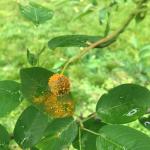 Pests/Problems: Cedar-quince rust (Gymnosporangium clavipes) was observed on serviceberry (Amelanchier spp.) and single-seeded hawthorn (Crataegus monogyna). This rust infects cedar/junipers and a wide range of rosaceous hosts. Avoid planting susceptible cedar and juniper varieties near susceptible rosaceous plants. For more information about cedar-quince rust, visit: https://ag.umass.edu/landscape/fact-sheets/cedar-quince-rust . Invasive Oriental bittersweet (Celastrus orbiculatus) vines are growing vigorously in the landscape. Pull out the oriental bittersweet vines when they are still young. They can be difficult to control once they become established in the landscape. Other weeds in the landscape continue to flourish. Take measures to control weeds before they set seed. Ticks and mosquitoes continue to be very active. Protect yourself with a repellent when working outdoors.
Pests/Problems: Cedar-quince rust (Gymnosporangium clavipes) was observed on serviceberry (Amelanchier spp.) and single-seeded hawthorn (Crataegus monogyna). This rust infects cedar/junipers and a wide range of rosaceous hosts. Avoid planting susceptible cedar and juniper varieties near susceptible rosaceous plants. For more information about cedar-quince rust, visit: https://ag.umass.edu/landscape/fact-sheets/cedar-quince-rust . Invasive Oriental bittersweet (Celastrus orbiculatus) vines are growing vigorously in the landscape. Pull out the oriental bittersweet vines when they are still young. They can be difficult to control once they become established in the landscape. Other weeds in the landscape continue to flourish. Take measures to control weeds before they set seed. Ticks and mosquitoes continue to be very active. Protect yourself with a repellent when working outdoors.
East Region (Boston)
General Conditions: The arrival of the Summer Solstice on June 20th gave us 15 hours and 17 minutes of daylight. With one week remaining, June has been 6.5˚F above average with only three days below average. We had a six day stretch with no precipitation until the afternoon of the 22nd when thunderstorms came through the area delivering 1.57 inches of welcome rainfall.
Pests/Problems: Rose slug sawfly (Endelomyia aethiops) continues to skeletonize rose foliage. Cedar apple rust is visible on Amelanchier spp. (shadbush) fruit. An outbreak of witch-hazel cone gall aphid (Hormaphis cornu) was seen on witch hazel (Hamamelis spp.) foliage. The aphid has an alternate birch host. By the time the galls are visible on witch hazel, it is basically an aesthetic issue. Scroll down to the third image in the article on the following site where you will find a short video describing and showing these aphids making the “witch’s cap galls”: https://www.hhmi.org/news/heres-how-insects-coax-plants-into-making-galls .
Metro West (Acton)
General Conditions: We welcome this first week of the summer season with this week’s report! The historical monthly average rainfall for June is 3.93 inches and as of the 22nd, only 2.4 inches of rain has been recorded for this month so far. Hopefully there will be more precipitation to come over the last 5 remaining days of the month to close this gap. Observed in some stage of bloom this past week were the following woody plants: Buddleia spp. (butterfly-bush), Calycanthus ’Aphrodite’ (Aphrodite allspice), Catalpa speciosa (northern catalpa), Cornus kousa (Kousa dogwood), Hydrangea arborescens (smooth hydrangea), Itea virginica (Virginia sweetspire), Kalmia latifolia (mountain laurel), Ligustrum spp. (privet), Magnolia sieboldii (oyama magnolia), Oxydendron arboreum (sourwood), Potentilla fruiticosa (potentilla), Rhododendron viscosum (swamp azalea), Rhus typhina (staghorn sumac), Rosa gallica (French rose), R. glauca (shrub rose), R. 'Knockout' (knockout family of roses), Rosa rugosa (beach rose), Rosa spp. (rose), Rubus odoratus (purple flowering raspberry), Sambucus canadensis (elderberry), Spiraea japonica 'Alpina' (daphne spirea), Stewartia psuedocamellia (Japanese Stewartia), Syringa reticulata (Japanese tree lilac), Tilia cordata (littleleaf linden) and Weigela florida (old fashioned weigela). Woody vines observed in bloom include Campsis radicans (trumpet vine) and Clematis spp. (clematis).
Contributing even more color and interest to the landscape are some flowering herbaceous plants including: Achillea millefolium (yarrow), Aruncus dioicus (goat’s beard), Asclepias syriaca (common milkweed), Campanula takesimana ‘Elizabeth’ (bell flower), Chrysogonum virginianum (green and gold), Clematis recta 'Purpurea' (clematis), Coreopsis spp. (tickseed), Dicentra eximia (fringed bleeding heart), Dictamnus albus (gas plant), Digitalis purpurea (foxglove), Filipendula spp. (meadow sweet), Geranium cantabrigiense 'Biokovo' and 'Cambridge' (hardy cranesbill), G. ‘Johnson’s Blue’ (cranesbill), G. sanguineum (bloody cranesbill), Hemerocallis fulva (orange daylily), H. 'Stella D'Oro', (daylily), H. spp. (daylily), Hosta spp. (plantain lily), Iris versicolor (blue flag iris), Leucanthemum sp. (shasta daisy), Lilium spp. (lily), Lupinus 'Russell Woodfield Hybrids' (lupine), Lychnis coronaria (rose campion), Monarda didyma (beebalm), Nepeta spp. (ornamental catmint), Oenothera macrocarpa (Ozark sundrop), Paeonia spp. (peony), Penstemon digitalis 'Husker Red' (beardtongue), Salvia nemerosa (salvia), Sedum kamtschaticum (Russian stonecrop), Stachys byzantina (lamb’s ear), Thermopsis caroliniana (southern lupine, blue ridge buck bean), Thymus praecox (thyme), Tradescantia spp. (spiderwort), and Veronica spp. (speedwell).
Pests/Problems: Many of our most invasive weeds have since flowered and are setting fruit and seed, including Alliaria petiolata (garlic mustard), Berberis thunbergii (barberry), Elaeagnus umbellata (autumn-olive), Euonymous alatus (burning bush), Lonicera maackii (Amur honeysuckle), and Rhamnus cathartica (common buckthorn). Convovulus arvensis (field bindweed) is in full bloom and is quite noticeable with its large and showy white flowers but don’t let its aggressive growth and habit trick you into thinking that it’s a plant for your garden!
Central Region (Boylston)
General Conditions: For the first few days of summer, the weather has been relatively mild in the Central region. The reporting period began with a stretch of high heat and humidity, but ended with a couple of very pleasant days, with almost cold overnight temperatures in the high 40’s. Our area experienced some rainfall this week, amounting to nearly ¼-inch of precipitation, keeping soils quite moist during what is typically the beginning of dry, summer conditions. There is plenty to admire in the garden this week, but hydrangea season is clearly upon us. Most are familiar with Hydrangea macrophylla, a species native to Japan, and its many cultivars. In the colder parts of the Central region, H. macrophylla flowers are not reliably winter hardy, so the ever-blooming cultivars like ‘Endless Summer’ are a better option to ensure consistent blooms in summer. We do have two common landscape species that are native to the eastern United States in H. arborescens, smooth hydrangea, and H. quercifolia, oakleaf hydrangea. Smooth hydrangea blooms on new wood and can be cut to the ground every year, while oakleaf hydrangea is a large woody shrub with beautiful exfoliating bark. Both are great choices for mid-summer flowers, especially in mild shade.
Pests/Problems: Fortunately, the threat of drought seems to have dissipated thanks to adequate rainfall over the last several weeks. There are no signs of gypsy moth caterpillar infestation in our region this year. Elderberry borer damage was spotted on Sambucus nigra, European elderberry.
Pioneer Valley Region (Amherst)
General Conditions: The summer solstice is behind us, but the summer season has plenty left in the tank as we round the corner in the month of June in the Pioneer Valley. Conditions over this past week were a mixture of warm and humid (6/19–6/21) to mild and pleasant (6/17–18, 6/23); a continuation of the variable weather we have experienced all month. For example, on 6/21, high temperatures hovered in the mid-80s while the dew point climbed to a swampy 73°F, pushing the heat index to 90°F. Overnight on 6/22, lows dropped down to only 71°F, with steady dew points near 70°F. After a very brief period of morning sun, the temperature and humidity started to drop for the rest of the day, with temperatures in the low 60s by late afternoon, causing a 30°F difference in high temperatures (with the heat index) over 24 hours. Precipitation over the past week was minimal, less than 0.5” throughout the valley. Scattered rain showers on 6/22 brought some brief periods of heavy rain, but nothing to write home about. The rain on 6/22 was a perfect example of why a high-quality rain gauge is necessary to determine exact rainfall amounts. Full sun soils are dry in the upper horizon but there’s moisture in lower horizons. Shaded soils remain adequately moist. No new water-use restrictions have been implemented in the tri-counties (https://www.mass.gov/doc/water-use-restrictions-map/download). While rainfall has been inadequate this summer, at this time last year the U.S. Drought Monitor categorized the entire Pioneer Valley in moderate drought conditions (D1). Depending on sun exposure and soil quality, turf grasses are either remaining green or browning out for the dormant stretch of mid-summer. Crabgrass is growing slowly, but steadily, and along with clover is a primary weed in many mulched landscaped beds. New growth continues on a variety of landscape trees and shrubs. Continue to scout closely for pest and pathogen activity.
Pests/Problems: Recently transplanted trees and shrubs can often exhibit major delays in flushing new growth, especially if a large mass of roots were removed during the process of planting. Regular watering for these plants will reduce the effects of transplant shock. However, over-watering can exacerbate transplant shock. Trees and shrubs do not require daily watering and irrigation should focus on soaking the root ball for only as long as necessary. Now is a good time to assess young, deciduous hardwoods to ensure they have a single leader. Trees like Japanese stewartia (Stewartia pseudocamellia), tend to develop multiple leaders that can detract from their appearance as they mature. Choose a single leader and prune out the competitors. As mentioned in a previous report, oak leaf blister (Taphrina caerulescens) is having a banner year in our region. Numerous oaks on the UMass campus have significant infections (pictured below on a Quercus coccinea). Lacebug injury on oaks is also visible now and can be distinguished from spider mite feeding by the presence of adult lacebugs and frass on the underside of the leaf. Powdery mildew on London plane tree (Platanus x acerifolia), caused by Erysiphe platani, is now starting to appear. While many powdery mildew pathogens cause little to no harm, infected plane trees can develop curled and distorted leaves. Dogwood powdery mildew, caused by Erysiphe pulchra and Phyllactinia guttata, was also found on both kousa (Cornus kousa) and flowering dogwood (C. florida) on the UMass campus. Symptoms appear as faint reddish-brown blotches and streaks on the foliage and the powdery white mycelia of the fungus is also quite faint. Premature leaf shedding can occur as result of infection and the disease was widespread in 2020. Juniper sawfly larvae (Monoctenus sp.) were observed on Chinese junipers (Juniperus chinensis ‘Kaizuka’ and J. chinensis ‘Robusta Green’). Unlike some other sawfly larvae on conifers, especially pines, juniper sawfly larvae do not feed in groups and occur singly. Damage is often minor and the larvae are easily controlled with hand-picking. Lily leaf beetle (Lilioceris lilii) larvae are active and damage is visible. Scout the underside of the leaves for maturing larvae and hand pick. Once larvae mature, they enter the soil to pupate, and this season's adults will emerge 16-22 days later. This generation typically does not mate or lay more eggs this season, but will overwinter in the soil or plant debris. Pests of lesser concern are also becoming common in the landscape. For example, slugs and earwigs. The latter prefer to spend their days in dark and concealed quarters and the inside of spiral-wrapped bark guards meet both these needs. 
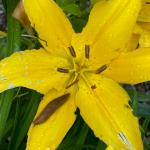
Berkshire Region (Great Barrington)
General Conditions: Rainfall in June has been sparse, to say the least, and soils were getting quite dry. So, it was a welcome relief when a thunderstorm rolled in on the night of the 21st and was followed the next day with intermittent showers. Prior to the rain, the precipitation deficit for the year was 4.12 inches as recorded on June 21 at the Pittsfield Airport. The deficit after the storm was reduced to 3.48 inches (June 23). The rain did moisten soils, at least for a few days. This created an ideal opportunity to apply mulches to landscape gardens, a maintenance practice which will help retain soil moisture. For the scouting period, the high/low temperatures and rainfall data at the three Berkshire County weather stations were: North Adams 89˚F (6/21)/43˚F (6/17), 1.07 inches rain; Pittsfield 85˚F (6/21)/43˚F (6/17), 0.76 inches rain; and Richmond 86˚F (6/21)/39˚F (6/17), 0.71 inches rain. Today, June 23, morning temperatures again dropped to well below normal as it was 43˚F at 6 AM in West Stockbridge. As an indication of the generally dry conditions, growth of turf grass has noticeably slowed. Also, after a fabulous spring characterized by prolonged bloom of most flowering trees and shrubs, the flowering period of recent bloomers comparatively seems much shorter. One thing that has not slowed is the growth of weeds.
Pests/Problems: One positive outcome of the dry weather is the lack of any persistent major plant disease. Most of the concern and chatter in Berkshire County and neighboring New York is about gypsy moth caterpillars. Infestations are heavy and defoliation of some trees can be seen. This scout collected 6 dozen caterpillars from a 6.5-foot tall sapling of copper beech. Besides beech, the most common hosts where the caterpillars were observed included oaks, birch, and other deciduous trees as well as blueberry bushes. Birch leaf miners are quite visible in the mined patches found on the foliage of birch. Imported willow leaf beetles continue to be found in all stages of their life cycle. Oriental garden beetle has made its appearance, typically ahead of Japanese beetles which have not yet been observed. But based on the number of grubs found when tilling soils, it could be a banner year Japanese beetle. This prediction is somewhat supported by increased mole activity, i.e. tunneling, in gardens and flower beds. Leaf galls are common on many tree species but especially on oaks.
Regional Scouting Credits
- CAPE COD REGION - Russell Norton, Horticulture and Agriculture Educator with Cape Cod Cooperative Extension, reporting from Barnstable.
- SOUTHEAST REGION - Brian McMahon, Arborist, reporting from the Dighton area.
- NORTH SHORE REGION - Geoffrey Njue, Green Industry Specialist, UMass Extension, reporting from the Long Hill Reservation, Beverly.
- EAST REGION - Kit Ganshaw & Sue Pfeiffer, Horticulturists reporting from the Boston area.
- METRO WEST REGION – Julie Coop, Forester, Massachusetts Department of Conservation & Recreation, reporting from Acton.
- CENTRAL REGION - Mark Richardson, Director of Horticulture reporting from Tower Hill Botanic Garden, Boylston.
- PIONEER VALLEY REGION - Nick Brazee, Plant Pathologist, UMass Extension Plant Diagnostic Lab, reporting from Amherst.
- BERKSHIRE REGION - Ron Kujawski, Horticultural Consultant, reporting from Great Barrington.
Woody Ornamentals
Diseases
Recent pests and pathogens of interest seen in the UMass Extension Plant Diagnostic Lab https://ag.umass.edu/services/plant-diagnostics-laboratory:
- Lacebug infestation, caused by Stephanitis spp., on Japanese andromeda (Pieris japonica). This mature plant resides in a residential foundation bed with no surrounding root competition. The site is characterized by light shade and well-drained soils. The shrub exhibited poor leaf color throughout the canopy and examination of the submitted sample revealed a well-established infestation. The upper surface of the leaves exhibited the conspicuous yellow-colored flecking with signs of the lacebug on the leaf underside. There are three species of Stephanitis that occur in our region that attack azalea, rhododendron and andromeda. While each of these Stephanitis species has a preferred host, the range of each species overlaps. Drought stress predisposes plants to infestation and lacebug populations often increase following drought years (i.e. 2020).
- Infestation of the oak shothole leafminer, oak anthracnose (Apiognomonia errabunda) and Tubakia leaf blotch (Tubakia sp.) on turkey oak (Quercus laevis). The tree is 20-years-old and has been present at the site for 15 years. It receives a mixture of sun and shade with good soils and drainage. The oak shothole leafminer causes only minor injury that has no lasting impact on the health of infested trees. However, the wounding that occurs on the developing leaves can be an important point of infection for foliar pathogens, as was the case here. The submitted foliage had irregular, black patches of necrotic tissue that is often associated with oak anthracnose. After incubating the leaf tissue, Tubakia was also present. Tubakia leaf blotch symptoms often appear later in the season despite the fact that infections occur in the spring.
- Needle blight on northern white-cedar (Thuja occidentalis ‘Degroot’s Spire’ and T. occidentalis ‘Linesville’) caused by cat urine marking. The plants are young, approximately five to seven-years-old, and were planted in a foundation bed in 2020. A male cat on the neighboring property is believed to be the culprit, perhaps establishing a territory boundary with a male cat at the tree owner’s property. Affected needles were blackened and had an oily residue from the urine, which was confirmed by its odor. The symptoms were distinct from those caused by fungal needle pathogens of Thuja. Pruning of the blighted needles has created gaps in the canopies on both plants but these should refill over time. A deer repellent was applied to the plants to discourage any additional marking.
- Top dieback of Norway spruce (Picea abies) caused by Setomelanomma holmii and Phomopsis. The tree is young, less than 10-years-old, and has been present at the current location for two years. It resides in sandy loam soils with partial shade and drip irrigation. A shoot tip blight was observed this season, with the greatest intensity at the top of the tree. Setomelanomma is believed to cause a condition called SNEED (sudden needle drop) on blue spruce (P. pungens). Norway spruce is not a regular host for this pathogen, as it may have greater resistance. In addition to the cankering fungi, the needle blight pathogen Rhizosphaera kalkhoffii was also detected. Norway spruce in landscape settings have suffered from various health issues in recent years, in contrast to their reputation as problem-free in comparison to blue spruce.

 Maple anthracnose, caused by Aureobasidium apocryptum and Discula campestris, on sugar (Acer saccharum), red (A. rubrum) and Japanese (A. palmatum) maples. Several reports and samples of maple anthracnose have emerged this season and damage from these common pathogens varies from year to year. Pictured here is a sugar maple infected by A. apocryptum. The tree is approximately 40- to 50-years-old and resides in a residential setting with full sun. The surrounding turfgrasses are fertilized annually, which may provide some supplemental nutrition for the tree. This spring, symptoms of anthracnose developed, which include angular spots and blotches, marginal leaf curling, leaf distortion and wilting. Maple anthracnose typically does not cause lasting injury to otherwise healthy trees, but for trees with various health problems, the disease takes on greater significance.
Maple anthracnose, caused by Aureobasidium apocryptum and Discula campestris, on sugar (Acer saccharum), red (A. rubrum) and Japanese (A. palmatum) maples. Several reports and samples of maple anthracnose have emerged this season and damage from these common pathogens varies from year to year. Pictured here is a sugar maple infected by A. apocryptum. The tree is approximately 40- to 50-years-old and resides in a residential setting with full sun. The surrounding turfgrasses are fertilized annually, which may provide some supplemental nutrition for the tree. This spring, symptoms of anthracnose developed, which include angular spots and blotches, marginal leaf curling, leaf distortion and wilting. Maple anthracnose typically does not cause lasting injury to otherwise healthy trees, but for trees with various health problems, the disease takes on greater significance.
Report by Nick Brazee, Plant Pathologist, UMass Extension Plant Diagnostic Lab, UMass Amherst.
Insects
Insects and Other Arthropods of Medical Importance:
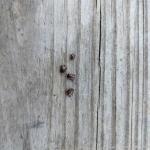
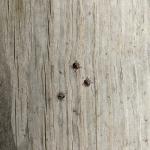 American Dog Tick: Anecdotally, Dermacentor variabilis has been prevalent in certain locations in Massachusetts in 2021. The images shown here are adult stage dog ticks removed from a dog following a roadside walk in Hampshire County on both 5/6/21 (4 ticks removed) and 5/7/21 (3 ticks removed). Looking for more updates? Check out UMass Extension’s Tick Check with Blake Dinius, Plymouth County Extension Service and Larry Dapsis, Cape Cod Cooperative Extension: https://www.youtube.com/watch?v=gryCv8qB1qw .
American Dog Tick: Anecdotally, Dermacentor variabilis has been prevalent in certain locations in Massachusetts in 2021. The images shown here are adult stage dog ticks removed from a dog following a roadside walk in Hampshire County on both 5/6/21 (4 ticks removed) and 5/7/21 (3 ticks removed). Looking for more updates? Check out UMass Extension’s Tick Check with Blake Dinius, Plymouth County Extension Service and Larry Dapsis, Cape Cod Cooperative Extension: https://www.youtube.com/watch?v=gryCv8qB1qw .
The American dog tick is found throughout most of North America. It may be encountered in forest edges, fields, along walkways and roadways, sidewalks, and trails. Adult stage ticks may be found on raccoons, skunks, cats, dogs, and other medium-sized hosts. Larvae and nymphs can be found on mice, voles, rats, and chipmunks. Adult males and females are active between April and early-August. Both adult males and females will feed, including on people. Nymphs and larvae of this species rarely attach to people or their pets. This species of tick can transmit lesser-known diseases such as Rocky Mountain Spotted Fever (not frequently infecting humans, according to CDC reports) and Tularemia (rarely infecting humans, according to CDC reports). For more information about the American dog tick, visit: https://web.uri.edu/tickencounter/species/dog-tick/ .
- Deer Tick/Blacklegged Tick: Check out the archived FREE TickTalk with TickReport webinars available here: https://ag.umass.edu/landscape/education-events/webinars .
*Ixodes scapularis - We are now entering the time of year when deer tick larvae and nymphs are frequently encountered. Larvae may be encountered in April, but in some locations may peak in their activity in August, while still being encountered through November. Nymphs are encountered from April through July, peaking in June. Nymphs are again present in October and November. For images of all deer tick life stages, along with an outline of the diseases they carry, and their timing of activity, visit: http://www.tickencounter.org/tick_identification/deer_tick .
Anyone working in the yard and garden should be aware that there is the potential to encounter deer ticks. The deer tick or blacklegged tick can transmit Lyme disease, human babesiosis, human anaplasmosis, and other diseases. Preventative activities, such as daily tick checks, wearing appropriate clothing, and permethrin treatments for clothing (according to label instructions) can aid in reducing the risk that a tick will become attached to your body. If a tick cannot attach and feed, it will not transmit disease. For more information about personal protective measures, visit: http://www.tickencounter.org/prevention/protect_yourself .
The Center for Agriculture, Food, and the Environment provides a list of potential tick identification and testing resources here: https://ag.umass.edu/resources/tick-testing-resources .
*Note that deer ticks (Ixodes scapularis) are not the only disease-causing tick species found in Massachusetts. The American dog tick (Dermacentor variabilis) and the lone star tick (Amblyomma americanum) are also found throughout MA. Each can carry their own complement of diseases, including others not mentioned above. Anyone working or playing in tick habitats (wood-line areas, forested areas, and landscaped areas with ground cover) should check themselves regularly for ticks while practicing preventative measures.
- Mosquitoes: According to the Massachusetts Bureau of Infectious Disease and Laboratory Science and the Department of Public Health, there are at least 51 different species of mosquito found in Massachusetts. Mosquitoes belong to the Order Diptera (true flies) and the Family Culicidae (mosquitoes). As such, they undergo complete metamorphosis, and possess four major life stages: egg, larva, pupa, and adult. Adult mosquitoes are the only stage that flies and many female mosquitoes only live for 2 weeks (although the life cycle and timing will depend upon the species). Only female mosquitoes bite to take a blood meal, and this is so they can make eggs. Mosquitoes need water to lay their eggs in, so they are often found in wet or damp locations and around plants. Different species prefer different habitats. It is possible to be bitten by a mosquito at any time of the day, and again timing depends upon the species. Many are particularly active from just before dusk, through the night, and until dawn. Mosquito bites are not only itchy and annoying, but they can be associated with greater health risks. Certain mosquitoes vector pathogens that cause diseases such as West Nile virus (WNV) and eastern equine encephalitis (EEE).
For more information about mosquitoes in Massachusetts, visit: https://www.mass.gov/service-details/mosquitoes-in-massachusetts .
There are ways to protect yourself against mosquitoes, including wearing long-sleeved shirts and long pants, keeping mosquitoes outside by using tight-fitting window and door screens, and using insect repellents as directed. Products containing the active ingredients DEET, permethrin, IR3535, picaridin, and oil of lemon eucalyptus provide protection against mosquitoes.
For more information about mosquito repellents, visit: https://www.mass.gov/service-details/mosquito-repellents and https://www.cdc.gov/mosquitoes/mosquito-bites/prevent-mosquito-bites.html .
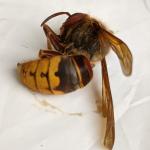
 Wasps/Hornets: Many wasps are predators of other arthropods, including pest insects such as certain caterpillars that feed on trees and shrubs. Adult wasps hunt prey and bring it back to their nest where young are being reared, as food for the immature wasps. A common such example are the paper wasps (Polistes spp.) who rear their young on chewed up insects. They may be seen searching plants for caterpillars and other soft-bodied larvae to feed their young. Paper wasps can sting, and will defend their nests, which are open-celled paper nests that are not covered with a papery “envelope”. These open-celled nests may be seen hanging from eaves or other outdoor building structures. Aerial yellow jackets and hornets create large aerial nests that are covered with a papery shell or “envelope”. Common yellow jacket species include those in the genus Vespula. Dolichovespula maculata is commonly known as the baldfaced hornet, although it is not a true hornet. The European hornet (Vespa crabro) is three times the size of a yellow jacket and may be confused for the Asian giant hornet (Vespa mandarinia). The European hornet is known to Massachusetts, but the Asian giant hornet is not. If you are concerned that you have found or photographed an Asian giant hornet, please report it here: https://massnrc.org/pests/report.aspx . Paper wasps and aerial yellowjackets overwinter as fertilized females (queens) and a single female produces a new nest annually in the late spring. Nests are abandoned at the end of the season. Queens start new nests, lay eggs, and rear new wasps to assist in colony/nest development.Some people are allergic to stinging insects, so care should be taken around wasp/hornet nests. Unlike the European honeybee (Apis mellifera), wasps and hornets do not have barbed stingers, and therefore can sting repeatedly when defending their nests. It is best to avoid their nests, and if that cannot be done and assistance is needed to remove them, consult a professional.
Wasps/Hornets: Many wasps are predators of other arthropods, including pest insects such as certain caterpillars that feed on trees and shrubs. Adult wasps hunt prey and bring it back to their nest where young are being reared, as food for the immature wasps. A common such example are the paper wasps (Polistes spp.) who rear their young on chewed up insects. They may be seen searching plants for caterpillars and other soft-bodied larvae to feed their young. Paper wasps can sting, and will defend their nests, which are open-celled paper nests that are not covered with a papery “envelope”. These open-celled nests may be seen hanging from eaves or other outdoor building structures. Aerial yellow jackets and hornets create large aerial nests that are covered with a papery shell or “envelope”. Common yellow jacket species include those in the genus Vespula. Dolichovespula maculata is commonly known as the baldfaced hornet, although it is not a true hornet. The European hornet (Vespa crabro) is three times the size of a yellow jacket and may be confused for the Asian giant hornet (Vespa mandarinia). The European hornet is known to Massachusetts, but the Asian giant hornet is not. If you are concerned that you have found or photographed an Asian giant hornet, please report it here: https://massnrc.org/pests/report.aspx . Paper wasps and aerial yellowjackets overwinter as fertilized females (queens) and a single female produces a new nest annually in the late spring. Nests are abandoned at the end of the season. Queens start new nests, lay eggs, and rear new wasps to assist in colony/nest development.Some people are allergic to stinging insects, so care should be taken around wasp/hornet nests. Unlike the European honeybee (Apis mellifera), wasps and hornets do not have barbed stingers, and therefore can sting repeatedly when defending their nests. It is best to avoid their nests, and if that cannot be done and assistance is needed to remove them, consult a professional.
Woody ornamental insect and non-insect arthropod pests to consider, a selected few:
Invasive Insects & Other Organisms Update:
 Spotted Lanternfly: (Lycorma delicatula, SLF) is not known to be established in Massachusetts landscapes at this time. However, due to the great ability of this insect to hitchhike using human-aided movement, it is important that we remain vigilant in Massachusetts and report any suspicious findings. Spotted lanternfly reports can be sent here: https://massnrc.org/pests/slfreport.aspx .
Spotted Lanternfly: (Lycorma delicatula, SLF) is not known to be established in Massachusetts landscapes at this time. However, due to the great ability of this insect to hitchhike using human-aided movement, it is important that we remain vigilant in Massachusetts and report any suspicious findings. Spotted lanternfly reports can be sent here: https://massnrc.org/pests/slfreport.aspx .
The Massachusetts Department of Agricultural Resources has recently released spotted lanternfly Best Management Practices for Nurseries and Landscapers: https://massnrc.org/pests/linkeddocuments/MANurseryBMPs.pdf
And Best Management Practices for Moving Companies and the Moving Industry: https://massnrc.org/pests/linkeddocuments/SLFChecklistMovingIndustryMA.pdf
Now is a great time to provide copies of these BMP’s to employees, customers, family, and friends! The more eyes we have out there looking for spotted lanternfly, the better. Use the above BMP’s as a guide to help you inspect certain items coming from CT, DE, MD, NC, NJ, NY, OH, PA, WV, and VA.
UMass Extension is teaming up with UMass Amherst’s Department of Environmental Conservation, the USDA APHIS, and the Massachusetts Department of Agricultural Resources to monitor for the spotted lanternfly in Massachusetts. A team including members of UMass Extension’s Landscape, Nursery, and Urban Forestry Program, Extension’s Fruit Program, Stockbridge School of Agriculture, and the Department of Environmental Conservation at UMass, Amherst are undertaking a nine-month integrated research and extension project to develop effective tools to detect the spotted lanternfly.
The researchers associated with this project (Dr. Joseph Elkinton, Dr. Jeremy Andersen and Dr. Jaime Pinero) will be working with Dr. Miriam Cooperband of the USDA APHIS lab on Cape Cod to identify and evaluate airborne attractants that can improve the ability to detect SLF in traps. Dr. Cooperband has identified several attractant lures released from host plants of SLF. She is currently working on pheromones produced by SLF that may be much more attractive. The UMass team will help her conduct field tests of these new lures, while also assisting the Massachusetts Department of Agricultural Resources (MDAR) in monitoring for SLF in Massachusetts. UMass Extension Entomologist, Tawny Simisky, will periodically report on progress made during the course of this project. For more information, please visit: https://ag.umass.edu/cafe/news/looking-for-spotted-lanternfly-recent-invasive-arrival
This insect is a member of the Order Hemiptera (true bugs, cicadas, hoppers, aphids, and others) and the Family Fulgoridae, also known as planthoppers. The spotted lanternfly is a non-native species first detected in the United States in Berks County, Pennsylvania and confirmed on September 22, 2014.
For a map of known, established populations of SLF as well as detections outside of these areas where individual finds of spotted lanternfly have occurred (but no infestations are present), visit: https://nysipm.cornell.edu/environment/invasive-species-exotic-pests/spotted-lanternfly/
The spotted lanternfly is considered native to China, India, and Vietnam. It has been introduced as a non-native insect to South Korea and Japan, prior to its detection in the United States. In South Korea, it is considered invasive and a pest of grapes and peaches. The spotted lanternfly has been reported feeding on over 103 species of plants, according to new research (Barringer and Ciafré, 2020) and when including not only plants on which the insect feeds, but those that it will lay egg masses on, this number rises to 172. This includes, but is not limited to, the following: tree of heaven (Ailanthus altissima) (preferred host), apple (Malus spp.), plum, cherry, peach, apricot (Prunus spp.), grape (Vitis spp.), pine (Pinus spp.), pignut hickory (Carya glabra), sassafras (Sassafras albidum), serviceberry (Amelanchier spp.), slippery elm (Ulmus rubra), tulip poplar (Liriodendron tulipifera), white ash (Fraxinus americana), willow (Salix spp.), American beech (Fagus grandifolia), American linden (Tilia americana), American sycamore (Platanus occidentalis), big-toothed aspen (Populus grandidentata), black birch (Betula lenta), black cherry (Prunus serotina), black gum (Nyssa sylvatica), black walnut (Juglans nigra), dogwood (Cornus spp.), Japanese snowbell (Styrax japonicus), maple (Acer spp.), oak (Quercus spp.), and paper birch (Betula papyrifera).
The adults and immatures of this species damage host plants by feeding on sap from stems, leaves, and the trunks of trees. In the springtime in Pennsylvania (late April - mid-May) nymphs (immatures) are found on smaller plants and vines and new growth of trees and shrubs. Third and fourth instar nymphs migrate to the tree of heaven and are observed feeding on trunks and branches. Trees may be found with sap weeping from the wounds caused by the insect’s feeding. The sugary secretions (excrement) created by this insect may coat the host plant, later leading to the growth of sooty mold. Insects such as wasps, hornets, bees, and ants may also be attracted to the sugary waste created by the lanternflies, or sap weeping from open wounds in the host plant. Host plants have been described as giving off a fermented odor when this insect is present.
Adults are present by the middle of July in Pennsylvania and begin laying eggs by late September and continue laying eggs through late November and even early December in that state. Adults may be found on the trunks of trees such as the tree of heaven or other host plants growing in close proximity to them. Egg masses of this insect are gray in color and look similar in some ways to gypsy moth egg masses.
Host plants, bricks, stone, lawn furniture, recreational vehicles, and other smooth surfaces can be inspected for egg masses. Egg masses laid on outdoor residential items such as those listed above may pose the greatest threat for spreading this insect via human aided movement.
For more information about the spotted lanternfly, visit this fact sheet: https://ag.umass.edu/landscape/fact-sheets/spotted-lanternfly .
- Emerald Ash Borer: (Agrilus planipennis, EAB) in 2021 alone, the Massachusetts Department of Conservation and Recreation has confirmed at least 22 new community detections of emerald ash borer in Massachusetts. To date, 11 out of the 14 counties in Massachusetts have confirmed emerald ash borer. (The remaining counties where EAB has yet to be detected are Barnstable, Dukes, and Nantucket counties.) A map of these locations and others previously known across the state may be found here: https://ag.umass.edu/fact-sheets/emerald-ash-borer .
This wood-boring beetle readily attacks ash (Fraxinus spp.) including white, green, and black ash and has also been found developing in white fringe tree (Chionanthus virginicus) and has been reported in cultivated olive (Olea europaea). Adult insects of this species will not be present at this time of year. Signs of an EAB infested tree may include (at this time) D-shaped exit holes in the bark (from adult emergence in previous years), “blonding” or lighter coloration of the ash bark from woodpecker feeding (chipping away of the bark as they search for larvae beneath), and serpentine galleries visible through splits in the bark, from larval feeding beneath. It is interesting to note that woodpeckers are capable of eating 30-95% of the emerald ash borer larvae found in a single tree (Murphy et al. 2018). Unfortunately, despite high predation rates, EAB populations continue to grow.
For further information about this insect, please visit: https://ag.umass.edu/fact-sheets/emerald-ash-borer . If you believe you have located EAB-infested ash trees, particularly in an area of Massachusetts not identified on the map provided, please report here: https://massnrc.org/pests/eabreport.htm .
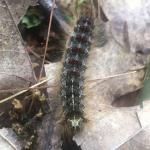

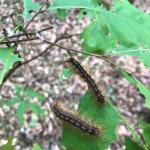


 Gypsy Moth:(Lymantria dispar) thanks to the gypsy moth caterpillar killing fungus, Entomophaga maimaiga, the recent widespread outbreak of gypsy moth in Massachusetts has come to an end! Most locations in Massachusetts will not see damaging or even noticeable populations of this insect in 2021. However, there have been recent reports of gypsy moth caterpillars feeding on susceptible hosts in some locations in western Massachusetts, particularly in Berkshire County (ex. Alford, Great Barrington, Richmond, South Egremont, and Williamstown). (Ex. On 6/9/21, a report from Great Barrington, MA noted that caterpillars were defoliating trees in a forested area, and that caterpillar frass (excrement) was seen raining down from the canopy.) While this may be the case in certain locations, we do not expect widespread defoliation (to the extent that we saw in 2017) from this insect in 2021 in MA. Another note for 6/9/2021: there have been reports of increased gypsy moth activity in certain locations in New York. Massachusetts residents vacationing or with second homes in that state are reporting defoliation on oaks and pines in NY. For more information, visit: https://www.dec.ny.gov/animals/83118.html . An update from 6/22/2021: defoliation of the canopy has also been observed by professionals working in Litchfield County, CT.
Gypsy Moth:(Lymantria dispar) thanks to the gypsy moth caterpillar killing fungus, Entomophaga maimaiga, the recent widespread outbreak of gypsy moth in Massachusetts has come to an end! Most locations in Massachusetts will not see damaging or even noticeable populations of this insect in 2021. However, there have been recent reports of gypsy moth caterpillars feeding on susceptible hosts in some locations in western Massachusetts, particularly in Berkshire County (ex. Alford, Great Barrington, Richmond, South Egremont, and Williamstown). (Ex. On 6/9/21, a report from Great Barrington, MA noted that caterpillars were defoliating trees in a forested area, and that caterpillar frass (excrement) was seen raining down from the canopy.) While this may be the case in certain locations, we do not expect widespread defoliation (to the extent that we saw in 2017) from this insect in 2021 in MA. Another note for 6/9/2021: there have been reports of increased gypsy moth activity in certain locations in New York. Massachusetts residents vacationing or with second homes in that state are reporting defoliation on oaks and pines in NY. For more information, visit: https://www.dec.ny.gov/animals/83118.html . An update from 6/22/2021: defoliation of the canopy has also been observed by professionals working in Litchfield County, CT.
Gypsy moth has been in Massachusetts since the 1860's. This invasive insect from Europe often goes unnoticed, thanks to population regulation provided by the entomopathogenic fungus, E. maimaiga, as well as a NPV virus specific to gypsy moth caterpillars. (And to a lesser extent many other organisms, including other insects, small mammals, and birds who feed on gypsy moth.) However, if environmental conditions do not favor the life cycle of the fungus, outbreaks of gypsy moth caterpillars are possible. (Such as most recently from 2015-2018, with a peak in the gypsy moth population in 2017 in Massachusetts.)
Check out Episode 1 of InsectXaminer to reminisce about the 2015-2018 outbreak of this insect: https://ag.umass.edu/landscape/education-events/insectxaminer
- Asian Longhorned Beetle: (Anoplophora glabripennis, ALB) Look for signs of an ALB infestation which include perfectly round exit holes (about the size of a dime), shallow oval or round scars in the bark where a female has chewed an egg site, or sawdust-like frass (excrement) on the ground nearby host trees or caught in between branches. Be advised that other, native insects may create perfectly round exit holes or sawdust-like frass, which can be confused with signs of ALB activity.
The regulated area for Asian longhorned beetle is 110 miles2 encompassing Worcester, Shrewsbury, Boylston, West Boylston, and parts of Holden and Auburn. If you believe you have seen damage caused by this insect, such as exit holes or egg sites, on susceptible host trees like maple, please call the Asian Longhorned Beetle Eradication Program office in Worcester, MA at 508-852-8090 or toll free at 1-866-702-9938.
To report an Asian longhorned beetle find online or compare it to common insect look-alikes, visit: http://massnrc.org/pests/albreport.aspx or https://www.aphis.usda.gov/pests-diseases/alb/report .
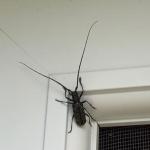
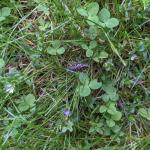 White Spotted Pine Sawyer (WSPS): Monochamus scutellatus adults emerge in late May throughout July, depending on local temperatures. This is a native insect in Massachusetts and is usually not a pest. Larvae develop in weakened or recently dead conifers, particularly eastern white pine (Pinus strobus). However, the white spotted pine sawyer looks very similar to the invasive Asian Longhorned Beetle, Anoplophora glabripennis, ALB. ALB adults do not emerge in Massachusetts until July and August. Beginning in July, look for the key difference between WSPS and ALB adults, which is a white spot in the top center of the wing covers (the scutellum) on the back of the beetle. White spotted pine sawyer will have this white spot, whereas Asian longhorned beetle will not. Both insects can have other white spots on the rest of their wing covers; however, the difference in the color of the scutellum is a key characteristic. See the Asian longhorned beetle entry above for more information about that non-native insect.
White Spotted Pine Sawyer (WSPS): Monochamus scutellatus adults emerge in late May throughout July, depending on local temperatures. This is a native insect in Massachusetts and is usually not a pest. Larvae develop in weakened or recently dead conifers, particularly eastern white pine (Pinus strobus). However, the white spotted pine sawyer looks very similar to the invasive Asian Longhorned Beetle, Anoplophora glabripennis, ALB. ALB adults do not emerge in Massachusetts until July and August. Beginning in July, look for the key difference between WSPS and ALB adults, which is a white spot in the top center of the wing covers (the scutellum) on the back of the beetle. White spotted pine sawyer will have this white spot, whereas Asian longhorned beetle will not. Both insects can have other white spots on the rest of their wing covers; however, the difference in the color of the scutellum is a key characteristic. See the Asian longhorned beetle entry above for more information about that non-native insect.
- Jumping Worms: In recent years, public concern about Amynthas spp. earthworms, collectively referred to as “jumping or crazy or snake” worms, has dramatically increased. University researchers and Extension groups in many locations in the US are finding that these species cause not only forest ecosystem disturbances, but may also negatively impact soil structure and reduce plant growth in gardens and managed landscapes. They do this by voraciously devouring the organic layer of the soil while feeding very close to the soil surface, unlike other species of earthworms. In woodland areas, they can quickly eat all of the leaf litter on the forest floor. Jumping worms also leave a distinct grainy soil full of worm castings. The soil becomes granular and may look like dried coffee grounds.
Unfortunately, there are currently no research-based management options available for these earthworms. So prevention is essential – preventing their introduction and spread into new areas is the best defense against them. Adult jumping worms can be 1.5 – 8 inches or more in length. Their clitellum (collar-like ring) is roughly located 1/3 down the length of the worm (from the head) and is smooth and cloudy-white and constricted. These worms may also wiggle or jump when disturbed, and can move across the ground in an S-shape like a snake. While the exact timing of their life cycle in MA might not be completely understood, their life cycle may be expected to go (roughly) something like this: they hatch in the late spring in 1-4 inches of soil, mature into adults during the summer and adults lay eggs sometime in August, and it is thought that their cocoons overwinter. (Adults perish with frost.) It is also worth noting here that jumping worms do not directly harm humans or pets.
For more information, listen to Dr. Olga Kostromytska’s presentation here: https://ag.umass.edu/landscape/education-events/invasive-insect-webinars .
Suggested reading includes Dr. Kostromytska’s recent “Hot Topics” article in Hort Notes (including an identification guide), here: https://ag.umass.edu/landscape/newsletters/hort-notes/hort-notes-2021-vol-323 .
Additional resources can also be found here:
University of Minnesota Extension: https://extension.umn.edu/identify-invasive-species/jumping-worms .
Cornell Cooperative Extension: http://ulster.cce.cornell.edu/environment/invasive-pests/jumping-worm .
UNH Extension: https://extension.unh.edu/blog/invasive-spotlight-jumping-worms .
Tree & Shrub Insects & Mites:
- Arborvitae Leafminer: In New England and eastern Canada, four species of leafminers are known to infest arborvitae. These include Argyresthia thuiella, A. freyella, A. aureoargentella, and Coleotechnites thujaella. The arborvitae leafminer, A. thuiella, is the most abundant of these and has the greatest known range when compared to the others. (It is also found in the Mid-Atlantic States and as far west as Missouri). Moths of this species appear from mid-June to mid-July and lay their eggs. The damage caused by all of these species is nearly identical. Trees, however, have been reported to lose up to 80% of their foliage due to arborvitae leafminer and still survive. At least 27 species of parasites have been reported as natural enemies of arborvitae leafminers, the most significant of which may be a parasitic wasp (Pentacnemus bucculatricis). Arborvitae leafminer damage causes the tips of shoots and foliage to turn yellow and brown. If infestations are light, prune out infested tips.

 Azalea Sawflies: There are a few species of sawflies that impact azaleas. Johnson and Lyon's Insects that Feed on Trees and Shrubs mentions three of them. Amauronematus azaleae was first reported in New Hampshire in 1895 and is likely found in most of New England. Adults of this species are black with some white markings and wasp-like. Generally green larvae feed mostly on mollis hybrid azaleas. Remember, sawfly caterpillars have at least enough abdominal prolegs to spell “sawfly” (so 6 or more prolegs). Adults are present in May, and females lay their eggs and then larvae hatch and feed through the end of June. There is one generation per year. Nematus lipovskyi has been reared from swamp azalea (Rhododendron viscosum). Adults of that species have been collected in April (in states to the south) and May (in New England) and larval feeding is predominantly in late April and May in Virginia and June in New England. One generation of this species occurs per year, and most mollis hybrid azaleas can be impacted. A third species, Arge clavicornis, is found as an adult in July and lays its eggs in leaf edges in rows. Larvae are present in August and September. Remember, Bacillus thuringiensis Kurstaki does not manage sawflies.
Azalea Sawflies: There are a few species of sawflies that impact azaleas. Johnson and Lyon's Insects that Feed on Trees and Shrubs mentions three of them. Amauronematus azaleae was first reported in New Hampshire in 1895 and is likely found in most of New England. Adults of this species are black with some white markings and wasp-like. Generally green larvae feed mostly on mollis hybrid azaleas. Remember, sawfly caterpillars have at least enough abdominal prolegs to spell “sawfly” (so 6 or more prolegs). Adults are present in May, and females lay their eggs and then larvae hatch and feed through the end of June. There is one generation per year. Nematus lipovskyi has been reared from swamp azalea (Rhododendron viscosum). Adults of that species have been collected in April (in states to the south) and May (in New England) and larval feeding is predominantly in late April and May in Virginia and June in New England. One generation of this species occurs per year, and most mollis hybrid azaleas can be impacted. A third species, Arge clavicornis, is found as an adult in July and lays its eggs in leaf edges in rows. Larvae are present in August and September. Remember, Bacillus thuringiensis Kurstaki does not manage sawflies.
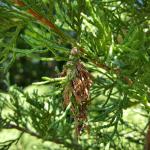 Bagworm: Thyridopteryx ephemeraeformis is a native species of moth whose larvae construct bag-like coverings over themselves with host plant leaves and twigs. This insect overwinters in the egg stage, within the bags of deceased females from last season. Eggs have hatched and very small, young larvae are observed feeding, as is typical around mid-June, or roughly between 600-900 GDD’s but will quickly grow in size. In certain areas across MA in 2020, increased populations of bagworms were observed and reported, particularly in urban forest settings and managed landscapes. More information can be found here: https://ag.umass.edu/landscape/fact-sheets/bagworm .
Bagworm: Thyridopteryx ephemeraeformis is a native species of moth whose larvae construct bag-like coverings over themselves with host plant leaves and twigs. This insect overwinters in the egg stage, within the bags of deceased females from last season. Eggs have hatched and very small, young larvae are observed feeding, as is typical around mid-June, or roughly between 600-900 GDD’s but will quickly grow in size. In certain areas across MA in 2020, increased populations of bagworms were observed and reported, particularly in urban forest settings and managed landscapes. More information can be found here: https://ag.umass.edu/landscape/fact-sheets/bagworm .- Cottony Taxus Scale: Pulvinaria floccifera, also referred to as the cottony camellia scale, utilizes such hosts as taxus, camellia, holly, hydrangea, Japanese maple, euonymus, magnolia, and jasmine, among others. Females have laid the long, narrow, white and fluffy egg sac that makes them much more noticeable. Eggs will hatch over an extended period of 6 weeks and crawlers may be treated between 802-1388 GDD’s. This insect can cause the host to appear off-color. They also produce honeydew which promotes sooty mold growth. Dieback is not common with this insect. Target the underside of the foliage. Horticultural oil, neem oil, and insecticidal soaps may be used to manage these soft scales. Reduced risk options help preserve natural enemies.
- Dogwood Borer: Synanthedon scitula is a species of clearwing moth whose larvae bore not only into dogwood (Cornus), but hosts also include flowering cherry, chestnut, apple, mountain ash, hickory, pecan, willow, birch, bayberry, oak, hazel, myrtle, and others. Kousa dogwood appear to be resistant to this species. Signs include the sloughing of loose bark, brown frass, particularly near bark cracks and wounds, dead branches, and adventitious growth. The timing of adult emergence can be expected when dogwood flower petals are dropping and weigela begins to bloom. Adult moth flights continue from then until September. Emergence in some hosts (ex. apple) appears to be delayed, but this differs depending upon the location in this insect’s range. Eggs are laid singly, or in small groups, on smooth and rough bark. Female moths preferentially lay eggs near wounded bark. After hatch, larvae wander until they find a suitable entrance point into the bark. This includes wounds, scars, or branch crotches. This insect may also be found in twig galls caused by other insects or fungi. Larvae feed on phloem and cambium. Fully grown larvae are white with a light brown head and approx. ½ inch long. Pheromone traps and lures are useful for determining the timing of adult moth emergence and subsequent management.

 Dogwood Sawfly: Macremphytus tarsatus larvae are commonly seen feeding on dogwoods, especially gray dogwood (Cornus racemosa). One generation occurs per year. The larvae of the dogwood sawfly overwinter in decaying wood and occasionally (rarely) compromised structural timber. An overwintering “cell” is created in this soft wood. Pupation occurs in the springtime and adults can take a lengthy time to emerge, roughly from late May through July. 100+ eggs are laid in groups on the underside of leaves. Eggs hatch and the larvae feed gregariously, initially skeletonizing the leaves. As the caterpillars grow in size, they are capable of eating the entire leaf, leaving only midveins behind. Larval appearance varies greatly throughout instars. Early instars are translucent and yellow, but as the caterpillars grow, they develop black spots (over the yellow) and become covered in a white powder-like material. Larvae and their shed skins may resemble bird droppings. Full-grown larvae begin to wander in search of a suitable overwintering location. Rotting wood lying on the ground is preferred for this. Sawfly caterpillars can be collected from plants and dropped into a can of soapy water.
Dogwood Sawfly: Macremphytus tarsatus larvae are commonly seen feeding on dogwoods, especially gray dogwood (Cornus racemosa). One generation occurs per year. The larvae of the dogwood sawfly overwinter in decaying wood and occasionally (rarely) compromised structural timber. An overwintering “cell” is created in this soft wood. Pupation occurs in the springtime and adults can take a lengthy time to emerge, roughly from late May through July. 100+ eggs are laid in groups on the underside of leaves. Eggs hatch and the larvae feed gregariously, initially skeletonizing the leaves. As the caterpillars grow in size, they are capable of eating the entire leaf, leaving only midveins behind. Larval appearance varies greatly throughout instars. Early instars are translucent and yellow, but as the caterpillars grow, they develop black spots (over the yellow) and become covered in a white powder-like material. Larvae and their shed skins may resemble bird droppings. Full-grown larvae begin to wander in search of a suitable overwintering location. Rotting wood lying on the ground is preferred for this. Sawfly caterpillars can be collected from plants and dropped into a can of soapy water.

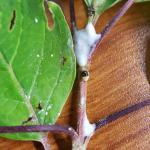 Dogwood Spittlebug: (Clastoptera proteus) occurs in New England, wherever dogwoods are grown. This species may also feed on Vaccinium and Aesculus. Adults and nymphs of this hemipteran are found feeding on the same host. The adult insect is called a froghopper. Eggs are laid in punctures created by adults in the bark of outer twigs. Each puncture may contain 1-3 eggs. Eggs overwinter and nymphs emerge in June and early July. A sugary, frothy substance is created by the feeding nymphs, as they secrete excess sap as they feed, causing it to froth by pumping air into this excrement. They can be completely hidden in this “spittle”. The impact these insects have is largely aesthetic, and management is rarely recommended.
Dogwood Spittlebug: (Clastoptera proteus) occurs in New England, wherever dogwoods are grown. This species may also feed on Vaccinium and Aesculus. Adults and nymphs of this hemipteran are found feeding on the same host. The adult insect is called a froghopper. Eggs are laid in punctures created by adults in the bark of outer twigs. Each puncture may contain 1-3 eggs. Eggs overwinter and nymphs emerge in June and early July. A sugary, frothy substance is created by the feeding nymphs, as they secrete excess sap as they feed, causing it to froth by pumping air into this excrement. They can be completely hidden in this “spittle”. The impact these insects have is largely aesthetic, and management is rarely recommended.

 Elm Casebearer: Coleophora ulmifoliella is a native North American moth that is found throughout New England and west to Michigan. Host plants include American, red, and slippery elm. Moths are tiny, with wing spans of approximately 13 mm. and buff in color with gray markings. According to Johnson and Lyon’s “Insects that Feed on Trees and Shrubs”, adult moths fly and mate and females lay eggs in July, at which point the eggs hatch and the larvae of the insect enter the host plant leaves to feed as miners between the epidermal layers of the leaf. As the larva grows in size, it emerges from the leaf it was mining and creates a case, which grows in size with it. This case serves as a protective covering, which the larva adorns itself with through the rest of the larval stage. Mines look like rectangular spots in the leaves that are brown in color. As the weather cools in the fall, the casebearer larva migrates to the twigs of its host plant, where it ties the case in one location to spend the winter as an immature larva. The following spring, the casebearer migrates to new leaves and resumes feeding as a miner, however it does this while dragging its case behind it and never allowing its body to completely leave the case. Elm casebearer cases are approximately 6 mm. in length. Once fully mature, the larvae pupate (within their individual cases) and adult moths emerge in July. A single generation occurs per year.
Elm Casebearer: Coleophora ulmifoliella is a native North American moth that is found throughout New England and west to Michigan. Host plants include American, red, and slippery elm. Moths are tiny, with wing spans of approximately 13 mm. and buff in color with gray markings. According to Johnson and Lyon’s “Insects that Feed on Trees and Shrubs”, adult moths fly and mate and females lay eggs in July, at which point the eggs hatch and the larvae of the insect enter the host plant leaves to feed as miners between the epidermal layers of the leaf. As the larva grows in size, it emerges from the leaf it was mining and creates a case, which grows in size with it. This case serves as a protective covering, which the larva adorns itself with through the rest of the larval stage. Mines look like rectangular spots in the leaves that are brown in color. As the weather cools in the fall, the casebearer larva migrates to the twigs of its host plant, where it ties the case in one location to spend the winter as an immature larva. The following spring, the casebearer migrates to new leaves and resumes feeding as a miner, however it does this while dragging its case behind it and never allowing its body to completely leave the case. Elm casebearer cases are approximately 6 mm. in length. Once fully mature, the larvae pupate (within their individual cases) and adult moths emerge in July. A single generation occurs per year.
Damage from a single elm casebearer larva is negligible and does not require management. However, on occasion, elevated populations of this insect do occur and noticeable injury to host plant leaves can transpire. Complete browning and death of leaves can occur, if high populations are present. Chemical management of this native insect is not necessary unless the majority of leaves contain more than a single larva.
- Elongate Hemlock Scale: Fiorinia externa is found on eastern, Carolina, and Japanese hemlock, as well as yew, spruce, and fir. The elongate hemlock scale may overwinter in various life stages, and overlap of many developmental stages at any given time can be observed throughout much of the season. Treatments for the crawler, or mobile, stage of this insect may be made in late May through mid-June, or between 360-700 GDD’s, base 50°F. Nitrogen fertilizer applications may make elongate hemlock scale infestations worse.
- Euonymus Scale: Unaspis euonymi is an armored scale that can be found on euonymus, holly, bittersweet, and pachysandra. This insect can cause yellow spotting on leaves, dieback, and distorted bark. For crawlers, early June timing is suggested between 533-820 GDD’s. (Eggs begin to hatch in early June.)

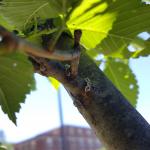 European Elm Scale: Gossyparia spuria is a type of felt scale.First noted in New York in 1884, this non-native scale is now widespread in North America and is found on native and European elms, but also rarely on hackberry and Zelkova. This insect can cause yellowing of foliage, premature leaf drop, and eventually dieback on its host. Honeydew and thus sooty mold are produced. Females will produce a ring of white fibers around their black, oval bodies. By the end of June, these females will lay eggs that hatch into bright yellow crawlers, which will disperse to the midrib and leaf veins on the underside of elm leaves where they will remain to feed. Crawlers are tiny and magnification is necessary to observe. Natural enemies such as parasitic wasps and predatory insects have been reported as successful in managing this insect.
European Elm Scale: Gossyparia spuria is a type of felt scale.First noted in New York in 1884, this non-native scale is now widespread in North America and is found on native and European elms, but also rarely on hackberry and Zelkova. This insect can cause yellowing of foliage, premature leaf drop, and eventually dieback on its host. Honeydew and thus sooty mold are produced. Females will produce a ring of white fibers around their black, oval bodies. By the end of June, these females will lay eggs that hatch into bright yellow crawlers, which will disperse to the midrib and leaf veins on the underside of elm leaves where they will remain to feed. Crawlers are tiny and magnification is necessary to observe. Natural enemies such as parasitic wasps and predatory insects have been reported as successful in managing this insect.- Fall Webworm: Hyphantria cunea is native to North America and Mexico. It is now considered a world-wide pest, as it has spread throughout much of Europe and Asia. (For example, it was introduced accidentally into Hungary from North America in the 1940’s.) Hosts include nearly all shade, fruit, and ornamental trees except conifers. In the USA, at least 88 species of trees are hosts for these insects, while in Europe at least 230 species are impacted. In the past history of this pest, it was once thought that the fall webworm was a two-species complex. It is now thought that H. cunea has two color morphs – one black headed and one red headed. These two color forms differ not only in the coloration of the caterpillars and the adults, but also in their behaviors. Caterpillars may go through at least 11 molts, each stage occurring within a silken web they produce over the host. When alarmed, all caterpillars in the group will move in unison in jerking motions that may be a mechanism for self-defense. Depending upon the location and climate, 1-4 generations of fall webworm can occur per year. Fall webworm adult moths lay eggs on the underside of the leaves of host plants in the spring. These eggs hatch in late June or early July depending on climate. Young larvae feed together in groups on the undersides of leaves, first skeletonizing the leaf and then enveloping other leaves and eventually entire branches within their webs. Webs are typically found on the terminal ends of branches. All caterpillar activity occurs within this tent, which becomes filled with leaf fragments, cast skins, and frass. Fully grown larvae then wander from the webs and pupate in protected areas such as the leaf litter where they will remain for the winter. Adult fall webworm moths emerge the following spring/early summer to start the cycle over again. 50+ species of parasites and 36+ species of predators are known to attack fall webworm in North America. Fall webworms typically do not cause extensive damage to their hosts. Nests may be an aesthetic issue for some. If in reach, small fall webworm webs may be pruned out of trees and shrubs and destroyed. Do not set fire to H. cunea webs when they are still attached to the host plant.
- Hemlock Looper: Two species of geometrid moths in the genus Lambdina are native insects capable of defoliating eastern hemlock, balsam fir, and white spruce. Adult moths lay their eggs on the trunk and limbs of hosts in September and October, and eggs will hatch by late May or early June. (L. fiscellaria caterpillars may be active between 448-707 GDD’s.) Monitor susceptible hosts for small, inch-worm like caterpillars. Where populations are low, no management is necessary. Hemlock loopers have several effective natural enemies.
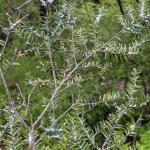
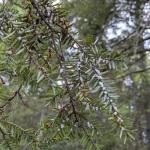
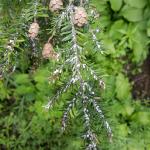 Hemlock Woolly Adelgid: Adelges tsugae is present on eastern and Carolina hemlock. The overwintering hemlock woolly adelgid generation (sistens) is present through mid-spring and produces the spring generation (progrediens) which will be present from early spring through mid-summer. HWA, unlike many other insects, does most of its feeding over the winter. Eggs may be found in woolly masses at the base of hemlock needles beginning in mid-March. Each woolly mass is created by a female who may then lay 50-300 eggs. Eggs hatch and crawlers may be found from mid-March through mid-July. Infested trees may be treated with foliar sprays in late April to early May, using Japanese quince as a phenological indicator. Systemic applications may be made in the spring and fall, or when soil conditions are favorable for translocation to foliage. Nitrogen fertilizer applications may make hemlock woolly adelgid infestations worse.
Hemlock Woolly Adelgid: Adelges tsugae is present on eastern and Carolina hemlock. The overwintering hemlock woolly adelgid generation (sistens) is present through mid-spring and produces the spring generation (progrediens) which will be present from early spring through mid-summer. HWA, unlike many other insects, does most of its feeding over the winter. Eggs may be found in woolly masses at the base of hemlock needles beginning in mid-March. Each woolly mass is created by a female who may then lay 50-300 eggs. Eggs hatch and crawlers may be found from mid-March through mid-July. Infested trees may be treated with foliar sprays in late April to early May, using Japanese quince as a phenological indicator. Systemic applications may be made in the spring and fall, or when soil conditions are favorable for translocation to foliage. Nitrogen fertilizer applications may make hemlock woolly adelgid infestations worse.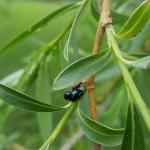
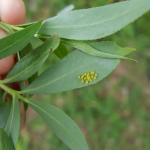 Imported Willow Leaf Beetle: Plagiodera versicolora adult beetles overwinter near susceptible hosts. Adult beetles will chew holes and notches in the leaves of willow once they become available. Females lay yellow eggs in clusters on the undersides of leaves. Larvae are slug-like and bluish-green in color. They will feed in clusters and skeletonize the leaves. Most plants can tolerate the feeding from this insect, and foliage will appear brown. Repeated yearly feeding can be an issue, in which case management of the young larvae may be necessary. Take care with treatment in areas near water.
Imported Willow Leaf Beetle: Plagiodera versicolora adult beetles overwinter near susceptible hosts. Adult beetles will chew holes and notches in the leaves of willow once they become available. Females lay yellow eggs in clusters on the undersides of leaves. Larvae are slug-like and bluish-green in color. They will feed in clusters and skeletonize the leaves. Most plants can tolerate the feeding from this insect, and foliage will appear brown. Repeated yearly feeding can be an issue, in which case management of the young larvae may be necessary. Take care with treatment in areas near water.
Check out Episode 4 of InsectXaminer to see the imported willow leaf beetle in action and learn more about its life cycle: https://ag.umass.edu/landscape/education-events/insectxaminer
- Lacebugs: Stephanitis spp. lacebugs such as S. pyriodes can cause severe injury to azalea foliage. S. rhododendri can be common on rhododendron and mountain laurel. S. takeyai has been found developing on Japanese andromeda, leucothoe, styrax, and willow. Stephanitis spp. lace bug activity should be monitored through September. Before populations become too large, treat with a summer rate horticultural oil spray as needed. Be sure to target the undersides of the foliage in order to get proper coverage of the insects. Certain azalea and andromeda cultivars may be less preferred by lace bugs.
- Lilac Borer: Podosesia syringae is a clearwing moth pest of lilac, privet, fringetree, and ash. (It is also known as the ash borer, not to be confused with the emerald ash borer.) Adults mimic paper wasps. Larvae are wood-boring, and signs and symptoms include branch dieback, holes, and occasionally, sawdust-like frass accumulated on bark. Larvae bore into stems, trunks, and branches, chewing an irregularly shaped entrance hole. Peak adult moth flights may occur in the northern portion of this insect’s range in June and is usually over by August 1st. Pheromone traps can be used to time adult emergence. Adult females lay flattened, oval, and tan eggs that are deposited singly or in clusters on bark crevices, ridges, and sometimes smooth bark; but usually laid in or near wounds in the bark. On average, 395 eggs are laid by each female. After hatch, larvae chew into the bark and feed laterally and then vertically in phloem tissue. Larvae overwinter in tunnels in the final instar and resume feeding in the spring. Adults emerge through a round exit hole (4-5 mm. in diameter). This insectmay be targeted between 200-299 GDD’s, base 50°F.

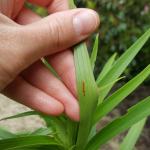
 Lily Leaf Beetle: Lilioceris lilii adults overwinter in sheltered places. As soon as susceptible hosts such as Lilium spp. (Turk’s cap, tiger, Easter, Asiatic, and Oriental lilies) and Fritillaria spp. break through the ground, the adult lily leaf beetles are known to feed on the new foliage. (Note: daylilies are not hosts.) Typically, in May, mating will occur and each female will begin to lay 250-450 eggs in neat rows on the underside of the foliage. If there are only a few plants in the garden, hand picking and destroying overwintering adults can help reduce local garden-level populations at that time. As eggs hatch and growing larvae begin to feed, the larvae of this insect can be removed from plants as well.
Lily Leaf Beetle: Lilioceris lilii adults overwinter in sheltered places. As soon as susceptible hosts such as Lilium spp. (Turk’s cap, tiger, Easter, Asiatic, and Oriental lilies) and Fritillaria spp. break through the ground, the adult lily leaf beetles are known to feed on the new foliage. (Note: daylilies are not hosts.) Typically, in May, mating will occur and each female will begin to lay 250-450 eggs in neat rows on the underside of the foliage. If there are only a few plants in the garden, hand picking and destroying overwintering adults can help reduce local garden-level populations at that time. As eggs hatch and growing larvae begin to feed, the larvae of this insect can be removed from plants as well.
Check out Episode 3 of InsectXaminer to see the lily leaf beetle in action and learn more about its life cycle: https://ag.umass.edu/landscape/education-events/insectxaminer
See the message in the box at the end of this Insect report to see how you can help with information about the lily leaf beetle.
 Magnolia Scale: Neolecanium cornuparvum is a soft scale that overwinters as first instar nymphs which are elliptical, and dark slate gray in color and can usually be found on the undersides of 1 and 2-year old twigs. Nymphs may molt by late April or May and again by early June at which time the scales may be purple in color. Eventually nymphs secrete a white powdery layer of wax over their bodies. On magnolia hosts, these large soft scales could either be Neolecanium cornuparvum, the magnolia scale, or Toumeyella liriodendri, the tuliptree scale. The tuliptree scale can be found both on magnolia and tuliptree hosts, whereas the magnolia scale is only known to magnolia. Differentiation between these two species of scale (on magnolia) can be difficult in the field. Soft scale nymphs were found on 6/23/2021 in Hampshire County, MA on Magnolia stellata ‘Royal Star’. A coating of black sooty mold also covered stems and twigs. Natural enemies of soft scales and other pests were also present- the mealybug destroyer (Cryptolaemus montrouzieri) and Hyperaspis spp. ladybeetle larvae.
Magnolia Scale: Neolecanium cornuparvum is a soft scale that overwinters as first instar nymphs which are elliptical, and dark slate gray in color and can usually be found on the undersides of 1 and 2-year old twigs. Nymphs may molt by late April or May and again by early June at which time the scales may be purple in color. Eventually nymphs secrete a white powdery layer of wax over their bodies. On magnolia hosts, these large soft scales could either be Neolecanium cornuparvum, the magnolia scale, or Toumeyella liriodendri, the tuliptree scale. The tuliptree scale can be found both on magnolia and tuliptree hosts, whereas the magnolia scale is only known to magnolia. Differentiation between these two species of scale (on magnolia) can be difficult in the field. Soft scale nymphs were found on 6/23/2021 in Hampshire County, MA on Magnolia stellata ‘Royal Star’. A coating of black sooty mold also covered stems and twigs. Natural enemies of soft scales and other pests were also present- the mealybug destroyer (Cryptolaemus montrouzieri) and Hyperaspis spp. ladybeetle larvae.
 The mealybug destroyer (Cryptolaemus montrouzieri) is a ladybeetle that was brought to the United States from Australia in 1891 by one of the early biological control pioneers in an effort to manage the citrus mealybug in California. The mealybug destroyer is a small dark brown lady beetle with a tan or orange head as an adult. Larvae have woolly appendages of wax, causing them to resemble mealybugs. This insect will feed not only on citrus mealybug, but soft scales and the long-tailed mealybug. A single larva can eat up to 250 mealybugs – they are voracious predators. Remember, the mealybug destroyer resembles its prey (a wolf in sheep’s clothing, if you will), so it is important to be able to identify this predator. C. montrouzieri is not known to be able to survive cold winters.
The mealybug destroyer (Cryptolaemus montrouzieri) is a ladybeetle that was brought to the United States from Australia in 1891 by one of the early biological control pioneers in an effort to manage the citrus mealybug in California. The mealybug destroyer is a small dark brown lady beetle with a tan or orange head as an adult. Larvae have woolly appendages of wax, causing them to resemble mealybugs. This insect will feed not only on citrus mealybug, but soft scales and the long-tailed mealybug. A single larva can eat up to 250 mealybugs – they are voracious predators. Remember, the mealybug destroyer resembles its prey (a wolf in sheep’s clothing, if you will), so it is important to be able to identify this predator. C. montrouzieri is not known to be able to survive cold winters.
 Hyperaspis spp. lady beetles may also be confused for mealybugs when they are in their larval stage. Adults of this genus may be tiny, black, and oval ladybugs with various red or orange markings or spots on the wings and thorax, depending upon the species. They feed on the egg masses of scale insects and appear at the same time scales begin to lay their eggs. Adults lay eggs on bark or leaves nearby scale infestations. Once the ladybeetle eggs hatch, their larvae feed on the eggs of the scales and grow in size. As the Hyperaspis spp. ladybeetle larvae grow in size, they secrete a dense, white, fluffy covering, causing them to resemble mealybugs.
Hyperaspis spp. lady beetles may also be confused for mealybugs when they are in their larval stage. Adults of this genus may be tiny, black, and oval ladybugs with various red or orange markings or spots on the wings and thorax, depending upon the species. They feed on the egg masses of scale insects and appear at the same time scales begin to lay their eggs. Adults lay eggs on bark or leaves nearby scale infestations. Once the ladybeetle eggs hatch, their larvae feed on the eggs of the scales and grow in size. As the Hyperaspis spp. ladybeetle larvae grow in size, they secrete a dense, white, fluffy covering, causing them to resemble mealybugs.
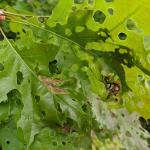
 Oak Shothole Leafminer: The oak shothole leafminer (Japanagromyza viridula synonym Agromyza viridula) is considered native to the United States, although very little is known about this species and other agromyzid leaf miners. It is reportedly found throughout the eastern U.S. from Maine to Georgia, and likely the entire eastern half of the United States. The damage caused by the activity of the adult female oak shothole leafminer is characteristic of this fly species. Adult female flies are active when red and white oak buds are just opening and until the newly developing leaves are approximately 5 cm (~2") in length. The holes seen in these images were created when the leaves were no more than 4.5 cm (~1 3/4") long. This damage is caused by the adult female fly feeding. Because the fly’s mouthparts are unable to pierce the newly developing leaf tissue, it uses its ovipositor to cause enough damage such that any fluids leaking from the leaf can then be lapped up. The female fly will move the ovipositor in side-to-side and circular motions, creating initial injury that is no more than 0.7 mm (~3/100") at its widest point on the tiny, newly developing leaves. The area injured by this action soon turns brown and dries, eventually forming a small disk. This disk of necrotic tissue often remains conspicuously attached to the expanding hole formed in the leaf. As the leaves grow in size, the damage from these flies enlarges, and the holes are described to be approximately six times the size of the original injury created by these tiny flies, who are themselves about 3 mm (~1/10") in length. Occasionally, the female fly will lay an egg in the leaf tissue.
Oak Shothole Leafminer: The oak shothole leafminer (Japanagromyza viridula synonym Agromyza viridula) is considered native to the United States, although very little is known about this species and other agromyzid leaf miners. It is reportedly found throughout the eastern U.S. from Maine to Georgia, and likely the entire eastern half of the United States. The damage caused by the activity of the adult female oak shothole leafminer is characteristic of this fly species. Adult female flies are active when red and white oak buds are just opening and until the newly developing leaves are approximately 5 cm (~2") in length. The holes seen in these images were created when the leaves were no more than 4.5 cm (~1 3/4") long. This damage is caused by the adult female fly feeding. Because the fly’s mouthparts are unable to pierce the newly developing leaf tissue, it uses its ovipositor to cause enough damage such that any fluids leaking from the leaf can then be lapped up. The female fly will move the ovipositor in side-to-side and circular motions, creating initial injury that is no more than 0.7 mm (~3/100") at its widest point on the tiny, newly developing leaves. The area injured by this action soon turns brown and dries, eventually forming a small disk. This disk of necrotic tissue often remains conspicuously attached to the expanding hole formed in the leaf. As the leaves grow in size, the damage from these flies enlarges, and the holes are described to be approximately six times the size of the original injury created by these tiny flies, who are themselves about 3 mm (~1/10") in length. Occasionally, the female fly will lay an egg in the leaf tissue.
The eggs hatch and mining from the larvae of the oak shothole leafminer is reported to occur in the second week of June in Maine, while in Ohio there are reports that the blotch mines created by this insect are most evident in early to mid-May in that state. Reportedly, fully grown larvae emerge from their mines to drop to the soil to pupate. Johnson and Lyon (1991) states that although adults are present the following spring, they may also reappear later in the same season “if a second flush of growth takes place or water sprouts (epicormic shoots) develop”. The oak shothole leafminer is not usually considered a significant pest of oak, and the damage it causes typically does not have a significant impact on the overall health of the tree. However, in a 1967 paper detailing observations from the 1960’s in Maine, there is a question about the economic importance of this species on ornamental oaks. In 1964, an “abundance of neat, prominent holes in foliage of ornamental red and white oaks (Quercus borealis var. maxima and Q. alba) in southern Maine” was observed. This was again observed in 1965. The cause, at the time determined to be Japanagromyza viridula, was identified by the State Entomologist with the Maine Forest Service and partners in the USDA. Their observations stated that many more “punctures” are made by the female for feeding than for oviposition (egg laying) and this is a common pattern of flies in this family. This might explain why the damage from the feeding adult females seems so extensive, whereas the mines from the feeding larvae of this insect are not present in the same proportion and may even be difficult to find.
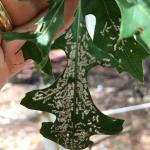
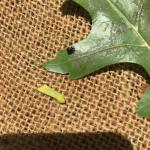 Oak Leafrolling Weevil: Synolabus bipustulatus (synonym Attelabus bipustulatus) is a small, stout, shiny, black weevil with two red spots, one on each elytra (hardened hindwing). (Another oak leaf rolling weevil species exists, Homoeolabus analis, but that insect is primarily orange in color with the exception of a black head and legs.) Weevils of this species (S. bipustulatus) are less than ¼ inch in size. The exact timing of this insect’s life cycle in Massachusetts is not completely understood, but adult weevils were observed by the Massachusetts Department of Agricultural Resources and reported to UMass Extension on 6/10/2021 from Middlesex County, Massachusetts. Adult weevils chew slits on either side of the midrib of the host plant leaf, where they will lay an egg at the tip of the leaf. The leaf is then folded (by the weevil) along the midrib and rolled into a tidy cylinder, kind of like a sleeping bag. By the end of this rolling, the egg is positioned near the center of the roll. Once the egg hatches, the immature weevil larva (which is legless, curved, and plump with a brown head) feeds on the tissue inside the rolled leaf. Once the larva matures, it pupates inside the rolled leaf. Adults emerge again to continue the life cycle and there may be multiple generations per year in certain locations of this insect’s geographic range. Leafrolling weevils have been noted on 16 species of oak and 2 species of chestnut. These insects are rarely considered pests, as they typically do not cause noticeable damage to their host plants. Management is seldom considered necessary.
Oak Leafrolling Weevil: Synolabus bipustulatus (synonym Attelabus bipustulatus) is a small, stout, shiny, black weevil with two red spots, one on each elytra (hardened hindwing). (Another oak leaf rolling weevil species exists, Homoeolabus analis, but that insect is primarily orange in color with the exception of a black head and legs.) Weevils of this species (S. bipustulatus) are less than ¼ inch in size. The exact timing of this insect’s life cycle in Massachusetts is not completely understood, but adult weevils were observed by the Massachusetts Department of Agricultural Resources and reported to UMass Extension on 6/10/2021 from Middlesex County, Massachusetts. Adult weevils chew slits on either side of the midrib of the host plant leaf, where they will lay an egg at the tip of the leaf. The leaf is then folded (by the weevil) along the midrib and rolled into a tidy cylinder, kind of like a sleeping bag. By the end of this rolling, the egg is positioned near the center of the roll. Once the egg hatches, the immature weevil larva (which is legless, curved, and plump with a brown head) feeds on the tissue inside the rolled leaf. Once the larva matures, it pupates inside the rolled leaf. Adults emerge again to continue the life cycle and there may be multiple generations per year in certain locations of this insect’s geographic range. Leafrolling weevils have been noted on 16 species of oak and 2 species of chestnut. These insects are rarely considered pests, as they typically do not cause noticeable damage to their host plants. Management is seldom considered necessary.
- Spruce Spider Mite: Oligonychus ununguis is a cool-season mite that becomes active in the spring from tiny eggs that have overwintered on host plants. Hosts include spruce, arborvitae, juniper, hemlock, pine, Douglas-fir, and occasionally other conifers. This particular species becomes active in the spring and can feed, develop, and reproduce through roughly June. When hot, dry summer conditions begin, this spider mite will enter a summer-time dormant period (aestivation) until cooler temperatures return in the fall. This particular mite may prefer older needles to newer ones for food. Magnification is required to view spruce spider mite eggs. Tapping host plant branches over white paper may be a useful tool when scouting for spider mite presence. (View with a hand lens.) Spider mite damage may appear on host plant needles as yellow stippling and occasionally fine silk webbing is visible.
Spruce spider mite populations may again build (with subsequent generations) in mid-late May (192-363 GDD’s) and again in late August to mid-September (2375-2806 GDD’s). Continue to scout for spruce spider mite by tapping branches over a white piece of paper or other white surface, then viewing them with a hand lens or other magnification. A general rule of thumb is that if 10 or more spruce spider mites are found per branch (in the absence of predatory mites), chemical management might be necessary (if you are also seeing roughly 10% of the foliage with stippling/discoloration). However, if you are finding light-colored and tear-drop shaped and fast-moving predatory mites, at a ratio of approximately 1 predatory mite: 10 spruce spider mites, these beneficial insect relatives may be able to help naturally keep spruce spider mite populations below damaging levels. It is important to also scout for predatory mites and beneficial insects (hover fly larvae, lacewing larvae, and lady beetle larvae and adults) while scouting for spruce spider mite, because knowledge of the presence of these beneficial predators will impact your management decisions. Broad spectrum insecticides/miticides should not be used to manage spruce spider mite on host plants where predatory mites are present as these chemicals could kill the predatory mites and lead to a subsequent surge in spruce spider mite populations.
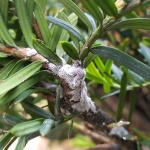 Taxus Mealybug: Dysmicoccus wistariae will produce honeydew and lead to sooty mold growth, yellowing of needles, and sparsely foliated plants. Eventual dieback may be possible. This species is commonly associated with taxus in New England, but can be occasionally found on dogwood, rhododendron, Prunus spp., maple, andromeda, and crabapple. These mealybugs are found on stems and branches and particularly like to congregate at branch crotches. Taxus mealybug feeds in the inner bark tissue of the trunk and branches. Adult females are present from June to August and give birth to living young in the summer. Immatures overwinter. A single generation may occur per year in New England, but areas to the south can have multiple generations of this insect. Management may be targeted between 246-618 GDD’s, base 50°F. Horticultural oil and neem oil may be used.
Taxus Mealybug: Dysmicoccus wistariae will produce honeydew and lead to sooty mold growth, yellowing of needles, and sparsely foliated plants. Eventual dieback may be possible. This species is commonly associated with taxus in New England, but can be occasionally found on dogwood, rhododendron, Prunus spp., maple, andromeda, and crabapple. These mealybugs are found on stems and branches and particularly like to congregate at branch crotches. Taxus mealybug feeds in the inner bark tissue of the trunk and branches. Adult females are present from June to August and give birth to living young in the summer. Immatures overwinter. A single generation may occur per year in New England, but areas to the south can have multiple generations of this insect. Management may be targeted between 246-618 GDD’s, base 50°F. Horticultural oil and neem oil may be used.
- Twolined Chestnut Borer: Agrilus bilineatus is a native jewel beetle (also known as a flatheaded borer) in the Family Buprestidae. This insect is also in the same genus as the invasive emerald ash borer. The twolined chestnut borer is native to Massachusetts, much of New England, and the eastern United States. This species has one generation per year and adults are typically active from April – August, depending upon location and temperature. Adults will conduct some maturation feeding on oak prior to mating. Females will lay clusters of tiny eggs in the cracks and crevices of bark. Larvae hatch from the eggs in 1-2 weeks and burrow through the bark into the cambium, where they feed in a similar manner to the emerald ash borer, creating meandering galleries as they feed. (The galleries of the twolined chestnut borer can be straight in very stressed trees.) Larvae typically mature by August – October and burrow to the outer bark where they create a chamber in which they overwinter. Pupation occurs the following spring and adults emerge through D-shaped exit holes that are approximately 1/5 inch wide. In the northern extent of this insect’s range, they can take 2 years to complete their life cycle. Larvae of this insect have been recorded from eastern white oak, common post oak, burr oak, scarlet oak, northern red oak, and eastern black oak. Adults have been recorded on fir and pin oak. These insects are attracted to stressed host plants and typically become a secondary factor in the decline of the tree.
- Two-Spotted Spider Mite: Tetranychus urticae is a “warm-season” mite that loves hot and dry weather, which may favor the quick reproduction and build-up of this pest. Management should seek to preserve beneficial predatory mites. Monitor susceptible hosts (elm, maple, redbud, ash, black locust, tuliptree, and many deciduous shrubs) for increasing numbers of these mites until mid-August. Mites will be found on the undersides of leaves and cause stippling of the foliage.
- Viburnum Leaf Beetle: Pyrrhalta viburni is a beetle in the family Chrysomelidae that is native to Europe, but was found in Massachusetts in 2004. Viburnum leaf beetle overwinters as eggs laid in capped pits on the newest growth of susceptible viburnum branches. Scout for overwintered eggs and prune out and destroy before they hatch. Egg hatch occurs in late-April to early-May as temperatures warm and foliage becomes available. Monitor for larvae in mid-May (80-120 GDD’s). This beetle feeds exclusively on many different species of viburnum, which includes, but is not limited to, susceptible plants such as V. dentatum, V. nudum, V. opulus, V. propinquum, and V. rafinesquianum. Some viburnum have been observed to have varying levels of resistance to this insect, including but not limited to V. bodnantense, V. carlesii, V. davidii, V. plicatum, V. rhytidophyllum, V. setigerum, and V. sieboldii. More information about viburnum leaf beetle may be found at http://www.hort.cornell.edu/vlb/ .
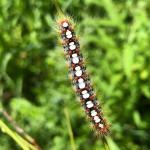 White Satin Moth: Leucoma salicis was recently reported from Beartown State Forest (Berkshire County) on 6/23/2021 by the Massachusetts Department of Conservation and Recreation, Forest Health Program. This is the same location that caterpillars of this species were seen defoliating their hosts in 2020. The caterpillars of this species have a unique color pattern, which helps us distinguish them from others. The dorsal (back) side of the caterpillar is marked with 10-11 white, intersegmental spots as well as paired, red “setal warts”. The sides of the caterpillars are blueish gray. These caterpillars are known to the edges of waterways, woodlands, and forests from Canada to northwestern Connecticut and central New York. One generation occurs per year with mature caterpillars known in May and June. Host plants include aspen, poplar, and willow and are fed upon by the caterpillars of this species.
White Satin Moth: Leucoma salicis was recently reported from Beartown State Forest (Berkshire County) on 6/23/2021 by the Massachusetts Department of Conservation and Recreation, Forest Health Program. This is the same location that caterpillars of this species were seen defoliating their hosts in 2020. The caterpillars of this species have a unique color pattern, which helps us distinguish them from others. The dorsal (back) side of the caterpillar is marked with 10-11 white, intersegmental spots as well as paired, red “setal warts”. The sides of the caterpillars are blueish gray. These caterpillars are known to the edges of waterways, woodlands, and forests from Canada to northwestern Connecticut and central New York. One generation occurs per year with mature caterpillars known in May and June. Host plants include aspen, poplar, and willow and are fed upon by the caterpillars of this species.
The white satin moth was introduced from Europe and first reported between Boston, MA and Hampton, New Hampshire in 1920. This insect is said to overwinter in the third instar (caterpillars pass through seven instars), either individually or in small groups. In the spring time, caterpillars leave their areas of hibernation to feed on nearby leaves. Caterpillars spin a thin cocoon between leaves or between exfoliating or thick bark crevices. Pupae are dark brown/black and often in a thin, loose silken sack. Pupae also sport brightly colored, yellow setae (hairs) that make them quite attractive. Pupation begins by the end of June. Shortly thereafter, moths emerge and females lay egg masses covered in a frothy, white material from July to mid-August. Eggs hatch sometime in August, and larvae will conduct feeding in August and September.
While caterpillars of this species are not noted to be of particular concern with regard to causing allergic reactions such as dermatitis, they are a type of tussock moth and do possess hairs, so they should not be handled and/or approached with caution particularly by sensitive individuals.
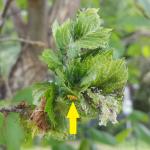 Woolly Apple Aphid: Eriosoma lanigerum may be found on apple, crabapple, hawthorn, mountain-ash, Pyracantha, and elm hosts. The primary (winter) host is elm, on which aphids infest emerging spring leaves, causing leaves to curl or close into stunted, rosette-like clusters found at twig tips. Woolly apple aphid was observed on elm on 6/1/2021 in Amherst, MA. Rosettes at this location are full of honeydew producing aphids. On apple and crabapple, this species of aphid colonizes roots, trunks, and branches in the summer and is commonly found near previous wounds or callous tissue. On roots, the aphids cause swelled areas which can girdle and kill roots. The aphids, when found in above ground plant parts such as elm leaves, are covered with white wax. Eggs are the overwintering stage on elm, which hatch in the spring in time for the nymphs to infest new elm foliage. Following a few generations on elm, the aphids will develop into a winged form, which will disperse and seek out apple and crabapple. Multiple generations will occur on these alternate hosts in the summer and by the fall, a winged form will return to elm and mated females will lay eggs near elm buds. These aphids are a favorite snack for insect predators such as the multicolored Asian lady beetle, Harmonia axyridis.
Woolly Apple Aphid: Eriosoma lanigerum may be found on apple, crabapple, hawthorn, mountain-ash, Pyracantha, and elm hosts. The primary (winter) host is elm, on which aphids infest emerging spring leaves, causing leaves to curl or close into stunted, rosette-like clusters found at twig tips. Woolly apple aphid was observed on elm on 6/1/2021 in Amherst, MA. Rosettes at this location are full of honeydew producing aphids. On apple and crabapple, this species of aphid colonizes roots, trunks, and branches in the summer and is commonly found near previous wounds or callous tissue. On roots, the aphids cause swelled areas which can girdle and kill roots. The aphids, when found in above ground plant parts such as elm leaves, are covered with white wax. Eggs are the overwintering stage on elm, which hatch in the spring in time for the nymphs to infest new elm foliage. Following a few generations on elm, the aphids will develop into a winged form, which will disperse and seek out apple and crabapple. Multiple generations will occur on these alternate hosts in the summer and by the fall, a winged form will return to elm and mated females will lay eggs near elm buds. These aphids are a favorite snack for insect predators such as the multicolored Asian lady beetle, Harmonia axyridis.
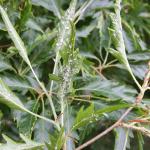 Woolly Beech (Leaf) Aphid: Phyllaphis fagi is a species of aphid commonly found on the leaf undersides of European beech, Fagus sylvatica, and its cultivars. This is a European species that is now widely distributed throughout North America. All life stages of this particular aphid occur on European beech foliage. European beech trees in North America have been observed as capable of holding large populations of this aphid year after year with little to no visible injury to the tree. Like their other aphid brethren, the woolly beech leaf aphid can create large quantities of sticky honeydew. These aphids were observed on Fagus sylvatica 'Asplenifolia' in Amherst, MA on 6/1/2021. The woolly beech leaf aphid is sometimes confused with another woolly aphid, also known as the beech blight aphid (Grylloprociphilus imbricator), which is only found on American beech, Fagus grandifolia. G. imbricator has an alternate common name, the boogie-woogie aphid, due to a behavior where this species, when colonies are disturbed, can wiggle (or dance) together, perhaps in an effort to distract potential predators.
Woolly Beech (Leaf) Aphid: Phyllaphis fagi is a species of aphid commonly found on the leaf undersides of European beech, Fagus sylvatica, and its cultivars. This is a European species that is now widely distributed throughout North America. All life stages of this particular aphid occur on European beech foliage. European beech trees in North America have been observed as capable of holding large populations of this aphid year after year with little to no visible injury to the tree. Like their other aphid brethren, the woolly beech leaf aphid can create large quantities of sticky honeydew. These aphids were observed on Fagus sylvatica 'Asplenifolia' in Amherst, MA on 6/1/2021. The woolly beech leaf aphid is sometimes confused with another woolly aphid, also known as the beech blight aphid (Grylloprociphilus imbricator), which is only found on American beech, Fagus grandifolia. G. imbricator has an alternate common name, the boogie-woogie aphid, due to a behavior where this species, when colonies are disturbed, can wiggle (or dance) together, perhaps in an effort to distract potential predators.
- Woolly Elm Aphid: Eriosoma americanum females lay a single egg in the cracks and crevices of elm bark, where the egg overwinters. Eggs hatch on elm in the spring as leaves are unfolding. Aphids may be active from 121-246 GDD’s, base 50°F on elm. A young, wingless female hatched from the egg feeds on the underside of leaf tissue. This female aphid matures and gives birth to 200 young, all females, without mating. These aphids feed, and the elm leaf curls around them and protects them. By the end of June, winged migrants mature and find serviceberry hosts. Another set of females is produced. These new females crawl to and begin feeding on the roots of serviceberry. Multiple generations occur on the roots of serviceberry through the summer.
Concerned that you may have found an invasive insect or suspicious damage caused by one? Need to report a pest sighting? If so, please visit the Massachusetts Introduced Pests Outreach Project: http://massnrc.org/pests/pestreports.htm .
Reported by Tawny Simisky, Extension Entomologist, UMass Extension Landscape, Nursery, & Urban Forestry Program
A Message from the University of Rhode Island Biocontrol Lab and Carleton University:
 Hello fellow gardeners, naturalists, and lily enthusiasts,
Hello fellow gardeners, naturalists, and lily enthusiasts,
It has been twenty years since biological control agents (parasitic wasps) were first released in North America to combat the lily leaf beetle, a destructive pest of Asiatic lilies and fritillaries in gardens as well as native lilies in natural areas. In many areas, control of the beetle has been so effective that it is now hard to find lily beetles. However, there are still some areas where the beetle is spreading unchecked.
At this time, it is important for us to update the status of the lily leaf beetle and its biocontrol agents across North America. This will help us determine how effective the agents are and how far they have spread from the release sites. We will also be able to prioritize areas that are heavily hit by the beetle for the next releases.
Please help us with this task by visiting the lily beetle tracker website and responding to a very short survey. There is also an opportunity, explained on the website, to help us gather data on parasitism rates across the country—this would make a good project for homeschooled kids.
https://lilybeetletracker.weebly.com/new-2021-citizen-science.html
Please share the link with your gardening groups, naturalists' groups and anyone else who might be interested.
Many thanks and have a lovely summer,
Naomi Cappuccino, Carleton University
Lisa Tewksbury and Dick Casagrande, University of Rhode Island Biocontrol Lab
For More Information, Visit:
https://web.uri.edu/biocontrol/lily-leaf-beetle-larval-collections-2016/llb-citizen-science-2020/#
Weeds
New growth expansion of poison ivy continues. Glyphosate or triclopyr are the best herbicides for poison ivy control and applications can be done from now until mid-September. Triclopyr products should be selected over glyphosate products in areas were grasses need to be saved. Contact (Scythe, Reward) or the non-chemical/organic herbicide products will provide “burndown” activity only and will not adequately control poison ivy.
Many people are asking if glufosinate (Finale or Cheetah Pro) can be used as a replacement for glyphosate. Glufosinate and glyphosate are both non-selective, postemergence herbicides. Glufosinate is not translocated or only limitedly so, whereas glyphosate is strongly translocated. Translocation is the movement of an herbicide from the point where the herbicide application comes in contact with the leaves of a weed to other parts of the plant including the roots and/or rhizomes. The translocation of an herbicide is an important characteristic which determines whether an herbicide will control a perennial weed, especially if the weed reproduces vegetatively via creeping roots or rhizomes. Glufosinate does not provide good control of perennial weeds as it is not translocated. In summary, glufosinate is not a one-to-one replacement for glyphosate.
Many landscape trees commonly produce vegetative suckers at their trunk base. Suckers are commonly seen on crabapple, flowering cherry, flowering pear, plum, linden, maple and sometimes oak. Honeylocust commonly produces vegetative sprouts along the entire length of their trunk. If these suckers or sprouts are not controlled, the landscape will be a contender for the “Shabby Landscape Award”. Pruning is effective but very time consuming. Another option would be to use the product Scythe that contains pelargonic acid to remove these vegetative suckers and sprouts when they are very small. Very small means less than one inch in length. Pelargonic acid is a contact herbicide. If Scythe is applied to small suckers and sprouts, the product will desiccate them and physical removal will not be required. Larger growth will first need to be physically removed and then Scythe can be used as a maintenance program. Products that contain glyphosate should not be used as glyphosate is a translocated herbicide and injury to the whole tree is possible.
A comment about the use of spray surfactants with herbicide applications. The rule is: “If an herbicide requires the addition of a surfactant, then one should be added per the label. If a surfactant is not required, then one should not be added”. If a required surfactant is not used, the efficacy of the herbicide can be significantly decreased to the point that the herbicide might not work. If a surfactant is added that is not needed, herbicide selectivity can be decreased, leading to with the possibility of injury or death of normally tolerant plants.
Report by Randy Prostak, Weed Specialist, UMass Extension Landscape, Nursery and Urban Forestry Program
Additional Resources
Pesticide License Exams - The MA Dept. of Agricultural Resources (MDAR) is now holding exams online. For more information and how to register, go to: https://www.mass.gov/pesticide-examination-and-licensing.
To receive immediate notification when the next Landscape Message update is posted, join our e-mail list or follow us on Facebook.
For a complete listing of upcoming events, see our upcoming educational events https://ag.umass.edu/landscape/upcoming-events
For commercial growers of greenhouse crops and flowers - Check out UMass Extension's Greenhouse Update website
For professional turf managers - Check out Turf Management Updates
For home gardeners and garden retailers - Check out our home lawn and garden resources.
Diagnostic Services
UMass Laboratory Diagnoses Landscape and Turf Problems - The UMass Extension Plant Diagnostic Lab is available to serve commercial landscape contractors, turf managers, arborists, nurseries and other green industry professionals. It provides woody plant and turf disease analysis, woody plant and turf insect identification, turfgrass identification, weed identification, and offers a report of pest management strategies that are research based, economically sound and environmentally appropriate for the situation. Accurate diagnosis for a turf or landscape problem can often eliminate or reduce the need for pesticide use. For sampling procedures, detailed submission instructions and a list of fees, see Plant Diagnostic Laboratory
Soil and Plant Nutrient Testing - The University of Massachusetts Soil and Plant Nutrient Testing Laboratory is located on the campus of The University of Massachusetts at Amherst. Testing services are available to all. The lab provides test results and recommendations that lead to the wise and economical use of soils and soil amendments. For more information, visit the UMass Soil and Plant Nutrient Testing Laboratory web site. Routine soil analysis and particle size analysis ONLY (no other types of soil analyses available at this time). Turnaround time: Please plan for the fact that date of receipt in the lab is affected by weekends, holidays, shipping time, and time for UMass Campus Mail to deliver samples to the lab. Campus Mail delivery only takes place on Monday, Wednesday, and Friday due to pandemic restrictions.
Tick Testing - The UMass Center for Agriculture, Food, and the Environment provides a list of potential tick identification and testing options at: https://ag.umass.edu/resources/tick-testing-resources.